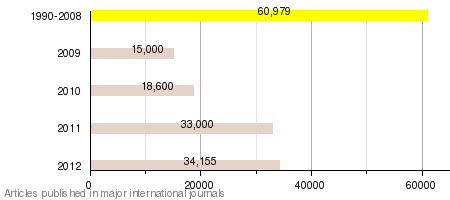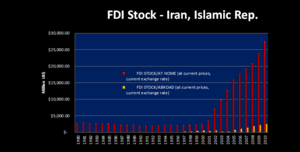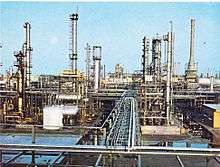Economy of Iran
The Economy of Iran is a mixed and transition economy with a large public sector. It is the world's eighteenth largest by purchasing power parity (PPP). Some 60% of Iran's economy is centrally planned.[24][25] It is dominated by oil and gas production, although over 40 industries are directly involved in the Tehran Stock Exchange, one of the best performing exchanges in the world over the past decade.[26][27] With 10% of the world's proven oil reserves and 15% of its gas reserves, Iran is considered an "energy superpower."[28][29][30][31][32] A unique feature of Iran's economy is the presence of large religious foundations called Bonyad, whose combined budgets represent more than 30 percent of central government spending.[33]
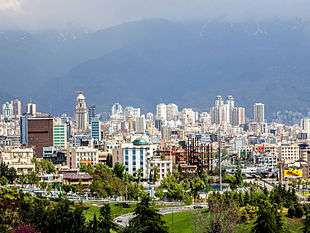 | |
| Currency | Iranian rial (IRR, |
|---|---|
| March 21–20 | |
Trade organizations | ECO, OPEC, GECF, WTO (observer) and others |
Country group |
|
| Statistics | |
| Population | |
| GDP | |
| GDP rank | |
GDP growth |
|
GDP per capita | |
GDP per capita rank | |
GDP by sector |
|
GDP by component |
|
| 34.2% (2020 est.)[6] | |
| NA[7] | |
Population below poverty line |
|
Labor force | |
| Unemployment | |
Average net salary | |
Main industries | petroleum, petrochemicals, fertilizers, caustic soda, car manufacture, parts, pharmaceuticals, home appliances, electronics, telecom, energy, power, textiles, construction, cement and other construction materials, food processing (particularly sugar refining and vegetable oil production), ferrous and non-ferrous metal fabrication, armaments |
| External | |
| Exports | |
Export goods | petroleum (56%),[18] chemical and petrochemical products, automobiles, fruits and nuts, carpets |
Main export partners |
|
| Imports | |
Import goods | industrial raw materials and intermediate goods (46%), capital goods (35%), foodstuffs and other consumer goods (19%), technical services |
Main import partners |
|
FDI stock | |
Gross external debt | |
| Public finances | |
| −2.3% (of GDP) (2017 est.)[7] | |
| Revenues | 37.1 billion (expected, Budget Law 2020/2021)[21] |
| Expenses | 37.1 billion (expected, Budget Law 2020/2021)[21] |
| |
Foreign reserves | |
Price controls and subsidies, particularly on food and energy,[34][35] are heavily prominent in the economy. Contraband, administrative controls, widespread corruption,[36][37] and other restrictive factors undermine private sector-led growth.[38] The government's 20-year vision (as of 2020), involves market-based reforms reflected in the government’s, with a five year development plan (2016/17 to 2021/22) focusing on "a resilient economy" and "progress in science and technology".[39]
Most of the country's exports are oil and gas, accounting for a majority of government revenue in 2010.[40][41]
GDP contracted in 2018 and 2019 and modest rebound is expected in 2020.[42] Challenges include COVID-19 outbreak starting in February 2020 and US sanctions reimposed in mid 2018, causing increased unemployment,[42] inflation,[39][42] a "chronically weak and undercapitalised" banking system,[42][43] and "anemic" private sector.[42] Iran's currency (Iranian rial) has fallen,[44] and Iran has a relatively low rating in "Economic Freedom",[45][42] and "ease of doing business".[46]
Iran's educated population, high human development, constrained economy and insufficient foreign and domestic investment prompted an increasing number of Iranians to seek overseas employment, resulting in a significant "brain drain".[38][47][48][49] However, in 2015, Iran and the P5+1 reached a deal on the nuclear program which removed most international sanctions. Consequently, the tourism industry was significantly improved and inflation decreased.[50]
History
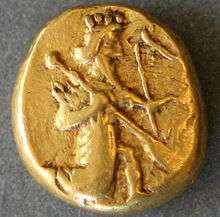
In 546 BC, Croesus of Lydia was defeated and captured by the Persians, who then adopted gold as the main metal for their coins.[51][52] There are accounts in the biblical Book of Esther of dispatches being sent from Susa to provinces as far out as India and the Kingdom of Kush during the reign of Xerxes the Great (485–465 BC). By the time of Herodotus (c. 475 BC), the Royal Road of the Persian Empire ran some 2,857 km from the city of Susa on the Karun (250 km east of the Tigris) to the port of Smyrna (modern İzmir in Turkey) on the Aegean Sea.
Modern agriculture in Iran dates back to the 1820s when Amir Kabir undertook a number of changes to the traditional agricultural system. Such changes included importing modified seeds and signing collaboration contracts with other countries. Polyakov's Bank Esteqrazi was bought in 1898 by the Tzarist government of Russia, and later passed into the hands of the Iranian government by a contract in 1920.[53] The bank continued its activities under the name of Bank Iran until 1933 when incorporating the newly founded Keshavarzi Bank.[53][54]
The Imperial Bank of Persia was established in 1885, with offices in all major cities of Persia.[53] Reza Shah Pahlavi (r. 1925–41) improved the country's overall infrastructure, implemented educational reform, campaigned against foreign influence, reformed the legal system, and introduced modern industries. During this time, Iran experienced a period of social change, economic development, and relative political stability.[54]
Reza Shah Pahlavi, who abdicated in 1941, was succeeded by his son, Mohammad Reza Shah Pahlavi (r. 1941–79). No fundamental change occurred in the economy of Iran during World War II (1939–45) and the years immediately following. However, between 1954 and 1960 a rapid increase in oil revenues and sustained foreign aid led to greater investment and fast-paced economic growth, primarily in the government sector. Subsequently, inflation increased, the value of the national currency (the rial) depreciated, and a foreign-trade deficit developed. Economic policies implemented to combat these problems led to declines in the rates of nominal economic growth and per capita income by 1961.[54]
Prior to 1979, Iran developed rapidly. Traditionally agricultural, by the 1970s, the country had undergone significant industrialization and modernisation.[55][56] The pace slowed by 1978 as capital flight reached $30 to $40 billion 1980-US dollars just before the revolution.[57]
Following the nationalizations in 1979 and the outbreak of the Iran–Iraq War, over 80% of the economy came under government control.[33] The eight-year war with Iraq claimed at least 300,000 Iranian lives and injured more than 500,000. The cost of the war to the country's economy was some $500 billion.[58][59]
After hostilities ceased in 1988, the government tried to develop the country's communication, transport, manufacturing, health care, education and energy sectors (including its prospective nuclear power facilities), and began integrating its communication and transport systems with those of neighbouring states.[60]
The government's long-term objectives since the revolution were stated as economic independence, full employment, and a comfortable standard of living but Iran's population more than doubled between 1980 and 2000 and its median age declined.[61] Although many Iranians are farmers, agricultural production has consistently fallen since the 1960s. By the late 1990s, Iran imported much of its food. At that time, economic hardship in the countryside resulted in many people moving to cities.[57]
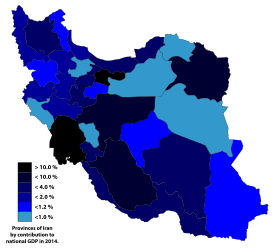 Provinces of Iran by contribution to national GDP (2014)
Provinces of Iran by contribution to national GDP (2014)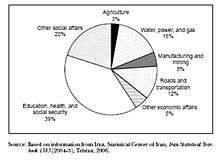 Socioeconomic expenditures (2004)
Socioeconomic expenditures (2004) Economic sectors (2002)
Economic sectors (2002) Inflation rate (1980–2010)
Inflation rate (1980–2010) Market liquidity (2012)
Market liquidity (2012) CPI, broad money and foreign exchange reserves (2000–2011)
CPI, broad money and foreign exchange reserves (2000–2011)- US dollar/Iranian rial exchange rate (2003–2014 est.)
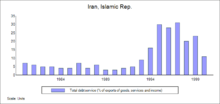 Debt service (1980–2000)
Debt service (1980–2000)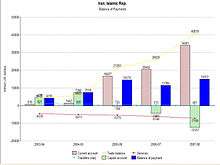 Balance of payment (2003–2007)
Balance of payment (2003–2007)
 Oil production and consumption (1977–2010)
Oil production and consumption (1977–2010)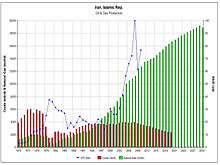 Oil and gas production (1970–2030 est.)
Oil and gas production (1970–2030 est.)
Macroeconomic trends
More than two-thirds of the population (74 million people) are under the age of 30. Net primary school enrollment is almost 100%, suggesting a secondary "demographic boom".[62][63][64]
Iran's national science budget in 2005 was about $900 million, roughly equivalent to the 1990 figure.[65] By early 2000, Iran allocated around 0.4% of its GDP to research and development, ranking the country behind the world average of 1.4%.[66] In 2009 the ratio of research to GDP was 0.87% against the government's medium-term target of 2.5%.[67] Iran ranked first in scientific growth in the world in 2011 and 17th in science production in 2012.[68][69]
Iran has a broad and diversified industrial base.[70] According to The Economist, Iran ranked 39th in a list of industrialized nations, producing $23 billion of industrial products in 2008.[71] Between 2008 and 2009 Iran moved to 28th from 69th place in annual industrial production growth because of its relative isolation from the 2008 international financial crisis.[72]
In the early 21st century, the service sector was the country's largest, followed by industry (mining and manufacturing) and agriculture. In 2008 GDP was estimated at $382.3 billion ($842 billion PPP), or $5,470 per capita ($12,800 PPP).[38]
Nominal GDP is projected to double in the next five years.[73] However, real GDP growth is expected to average 2.2% a year in 2012–16, insufficient to reduce the unemployment rate.[74] Furthermore, international sanctions have damaged the economy by reducing oil exports by half before recovering in 2016.[75][76] The Iranian rial lost more than half of its value in 2012, directing Iran at an import substitution industrialization and a resistive economy.[75][77][78] According to the International Monetary Fund, Iran is a "transition economy", i.e., changing from a planned to a market economy.[79]
The United Nations classifies Iran's economy as semi-developed.[80] In 2014, Iran ranked 83rd in the World Economic Forum's analysis of the global competitiveness of 144 countries.[81][82][83] Political, policy and currency stability are regarded as the most problematic factors in doing business in Iran. Difficulty in accessing financing is also a major concern, especially for small and medium enterprises. Most of Iran's financial resources are directed at trading, smuggling and speculation instead of production and manufacturing.[84] According to Goldman Sachs, Iran has the potential to become one of the world's largest economies in the 21st century.[85][86] Iranian President Hassan Rouhani stated, in 2014, that the country has the potential to become one of the ten largest economies within the next 30 years.[87]
- GDP, PPP, million (current international $)
- GDP per capita, PPP (current international $)
.jpg)
| Year (Source: IMF)[88] | GDP, current prices (billions IRR) | Implied PPP conversion rate (USD/IRR) | GDP per capita, PPP (current international dollar) | Inflation index (average CPI) (2011/2012=100) | Current account balance (billions US dollars) | Population (million persons) |
|---|---|---|---|---|---|---|
| 1980 | 6,622 | 40 | 4,267 | 0.5 | -3.6 | 38 |
| 1985 | 16,556 | 53 | 6,469 | 0.9 | -0.9 | 48 |
| 1990 | 35,315 | 101 | 6,410 | 2.5 | -2.7 | 55 |
| 1995 | 185,928 | 399 | 7,265 | 9 | 3.4 | 64 |
| 2000 | 580,473 | 940 | 9,666 | 21 | 12.5 | 64 |
| 2005 | 1,831,739 | 2,025 | 13,036 | 40 | 15.4 | 69 |
| 2010 | 4,333,088 | 3,498 | 16,664 | 82 | 27.3 | 74 |
| 2015 (est.) | 13,077,142 | 9,788 | 16,918 | 253 | 6.9 | 79 |
Reform plan
Expansion of public healthcare and international relations are the other main objectives of the fifth plan, an ambitious series of measures that include subsidy reform, banking recapitalization, currency, taxation, customs, construction, employment, nationwide goods and services distribution, social justice and productivity.[89] The intent is to make the country self-sufficient by 2015 and replace the payment of $100 billion in subsidies annually with targeted social assistance.[90][91][92][93] These reforms target the country's major sources of inefficiency and price distortion and are likely to lead to major restructuring of almost all economic sectors.[91] As such, by removing energy subsidies, Iran intends to make its industries more efficient and competitive.[94] By 2016, one third of Iran's economic growth is expected to originate from productivity improvement. Energy subsidies left the country one of the world's least energy-efficient, with energy intensity three times the global average and 2.5 times higher than the Middle Eastern average.[95] The banking sector is seen as a potential hedge against the removal of subsidies, as the plan is not expected to directly impact banks.[96]
National planning
Iran's budget is established by the Management and Planning Organization of Iran and proposed by the government to the parliament before the year's end. Following approval of the budget by Majlis, the central bank presents a detailed monetary and credit policy to the Money and Credit Council (MCC) for approval. Thereafter, major elements of these policies are incorporated into the five-year economic development plan.[54] The fifth development plan, for 2010–15, is designed to delegate power to the people and develop a knowledge economy.[97] The plan is part of "Vision 2025", a strategy for long-term sustainable growth.[98]
| Item | 2010 (achieved) | 2010–15 (target) |
|---|---|---|
| GDP world ranking | 18th largest economy by PPP[99] | 12th in 2015;[100] Goldman Sachs estimate: 12th by 2025[101] |
| Annual growth rate | 2.6% | 8% on average (based on $1.1 trillion domestic and FDI);[102][103] BMI forecast: 3.6% on average (2009–14)[104] |
| Unemployment | 11.8% according to government; unofficially: 12–22%;[105] 30% according to opposition[106] | 7% by 2015, by creating 1 million new jobs each year[102] |
| Inflation rate | 15% (as of January 2010) | 12% on average[102] |
| Value Added Tax | 3% | 8%[107] |
| Privatization | N/A | 20% of state-owned firms to be privatized each year[108] |
| Share of cooperative sector (% GDP) | < 5%[109] | 25%[110] |
| R&D (% GDP) | 0.87% | 2.5%[67] |
| Share of non-oil exports | 20% | 30% ($83 billion) by 2016[102][107][111] |
| Oil price & revenues in budget | $60 per barrel | $65 per barrel on average[102] / $250 billion in oil and gas revenues[112] in 2015 once the current projects come on stream; International Monetary Fund projections: ~$60 billion only[113] |
| National Development Fund | N/A | 30% of oil revenues to be allocated to the National Development Fund by 2015[114] |
| Oil production | 4.1 million bpd | 5.2 million bpd (with some 2,500 oil and gas wells to be drilled and commissioned)[115][116] |
| Natural gas production | N/A | 900 million cubic meter/day[117] |
| R&D projects in oil industry | N/A | Implementation of 380 research projects by 2015 covering the enhancement of the recovery rate, gas conversion and hydro conversion[118] |
| Investment in oil and gas industry | N/A | $20 billion a year in private and foreign investment, in part to boost oil refining capacity[102][119] |
| Petrochemical output | ~50 million tpy | 100 million tpy[120][121] |
| Bunkering | 25% market share in Persian Gulf | 50% market share or 7.5 million tpy of liquid fuel[122] |
| Oil products storage capacity | 11.5 billion liters | 16.7 billion liters[123] |
| Natural gas storage capacity | N/A | 14 billion cubic meters[124] |
| Electricity generation capacity | 61,000 MW | 86,000 MW[125] |
| Efficiency of power plants | 38% | 45%[126] |
| Investment in mining and industry | N/A | $70 billion / 700,000 billion rials[127] |
| Crude steel production | ~10 million tpy | 42 million tpy by 2015[127] |
| Iron ore production | ~27 million tpy | 66 million tpy by 2015[127] |
| Cement | ~71 million tpy | 110 million tpy[127] |
| Limestone | N/A | 166 million tpy[127] |
| Industrial parks | N/A | 50 new industrial parks to be built by 2015[128] |
| Ports capacity | 150 million tons | 200 million tons[129] |
| Railways | 10,000 kilometers[130] | 15,000 kilometers by 2015 at a cost of $8 billion per annum[91] |
| Transit | 7 million tons | 40 million tons of goods[131][132] |
| Electronic trade | N/A | 20% of domestic trade, 30% of foreign trade and 80% of government transactions to be made electronically[133] |
- Sixth development plan (2016–2021)
The sixth five-year development plan for the 2016–2021 period places emphasis on "guidelines" rather than "hard targets".[134] It defines only three priorities:
- the development of a resilient economy;
- progress in science and technology;
- and the promotion of cultural excellence.[135]
Fiscal and monetary policy
Since the 1979 revolution, government spending has averaged 59% on social policies, 17% on economic matters, 15% on national defense, and 13% on general affairs.[54] Payments averaged 39% on education, health and social security, 20% on other social programs, 3% on agriculture, 16% on water, power and gas, 5% on manufacturing and mining, 12% on roads and transportation and 5% on other economic affairs.[54] Iran's investment reached 27.7% of GDP in 2009.[38] Between 2002 and 2006, inflation fluctuated around 14%.[136] In 2008, around 55% of government revenue came from oil and natural gas revenue, with 31% from taxes and fees.[137][138] There are virtually millions of people who do not pay taxes in Iran and hence operate outside the formal economy.[38] The budget for year 2012 was $462 billion, 9% less than 2011.[139] The budget is based on an oil price of $85 per barrel. The value of the US dollar is estimated at IRR 12,260 for the same period.[139] According to the head of the Department of Statistics of Iran, if the rules of budgeting were observed the government could save at least 30 to 35% on its expenses.[140] The central bank's interest rate is 21%, and the inflation rate has climbed to 22% in 2012, 10% higher than in 2011.[141] There is little alignment between fiscal and monetary policy. According to the Central Bank of Iran, the gap between the rich and the poor narrowed because of monthly subsidies but the trend could reverse if high inflation persists.[142]
Iran had an estimated $110 billion in foreign reserves in 2011[143] and balances its external payments by pricing oil at approximately $75 per barrel.[144] As of 2013, only $30 to $50 billion of those reserves are accessible because of current sanctions.[145] Iranian media has questioned the reason behind Iran's government non-repatriation of its foreign reserves before the imposition of the latest round of sanctions and its failure to convert into gold. As a consequence, the Iranian rial lost more than 40% of its value between December 2011 and April 2012.[142] Iran's external and fiscal accounts reflect falling oil prices in 2012–13, but remain in surplus. The current account was expected to reach a surplus of 2.1% of GDP in 2012–13, and the net fiscal balance (after payments to Iran's National Development Fund) will register a surplus of 0.3% of GDP.[74] In 2013 the external debts stood at $7.2 billion down from $17.3 billion in 2012.[146] Overall fiscal deficit is expected to deteriorate to 2.7% of GDP in FY 2016 from 1.7% in 2015.[147]
Challenges
The GDP of Iran contracted in 2018/19 and 2019/20 and modest rebound is expected in 2020/2021 according to an April 2020 World Economic Outlook by the IMF.[42] Challenges to the economy include the COVID-19 outbreak starting in February 2020, which on top of US sanctions reimposed in mid 2018 and other factors, led a fall in oil production and are projected to lead to a slow recovery in oil exports.[39] Labor-force participation has risen[42] but unemployment is above 10% as of 2020 and projected to rise in 2021 and 2022.[42] Inflation reached 41.1% in 2019, and is expected to continue "in the coming years" according to the World Bank,[39] but decline into the 34-33% range.[42] Iran's banking system is "chronically weak and undercapitalised" according to Nordea Bank Abp,[42] holding billions of dollars of non-performing loans,[43] and the private sector remains "anemic".[42] The unofficial Iranian rial to US dollar exchange rate, which had plateaued at 40,000 to one in 2017, has fallen 120,000 to one as of November 2019.[44] Iran's economy has a relatively low rating in the Heritage Foundation's "Index of Economic Freedom" (164 out of 180);[45][42] and ease of doing business ranking (127 among 190) according to the World Bank.[46] Critics have complained that privatization has led not to state owned businesses being taken over by "skilled businesspeople" but by the powerful Islamic Revolutionary Guard Corps "and its associates".[148] In 2020, an Iranian businessperson complained to a foreign journalist (Dexter Filkins) that the uncertainty of "chronic shortages of material and unruly inspectors pushing for bribes" made operating his business very difficult -- “Plan for the next quarter? I can’t plan for tomorrow morning.”[148]
Ownership
Following the hostilities with Iraq, the Government declared its intention to privatize most industries and to liberalize and decentralize the economy.[152] Sale of state-owned companies proceeded slowly, mainly due to opposition by a nationalist majority in the parliament. In 2006, most industries, some 70% of the economy, remained state-owned.[38] The majority of heavy industries including steel, petrochemicals, copper, automobiles, and machine tools remained in the public sector, with most light industry privately owned.[38]
Article 44 of the Iranian Constitution declares that the country's economy should consist of state, cooperative, and private based sectors. The state sector includes all large-scale industries, foreign trade, major minerals, banking, insurance, power generation, dams and large-scale irrigation networks, radio and television, post, telegraph and telephone services, aviation, shipping, roads, railroads and the like. These are publicly owned and administered by the State. Cooperative companies and enterprises concerned with production and distribution in urban and rural areas form the basis of the cooperative sector and operated in accordance with Shariah law. As of 2012, 5,923 consumer cooperatives, employed 128,396.[153] Consumer cooperatives have over six million members.[153] Private sector operate in construction, agriculture, animal husbandry, industry, trade, and services that supplement the economic activities of the state and cooperative sectors.[154]
Since Article 44 has never been strictly enforced, the private sector has played a much larger role than that outlined in the constitution.[155] In recent years, the role of this sector has increased. A 2004 constitutional amendment allows 80% of state assets to be privatized. Forty percent of such sales are to be conducted through the "Justice Shares" scheme and the rest through the Tehran Stock Exchange. The government would retain the remaining 20%.[156][157] In 2005, government assets were estimated at around $120 billion. Some $63 billion of such assets were privatized from 2005 to 2010, reducing the government's direct share of GDP from 80% to 40%.[24] Many companies in Iran remain uncompetitive because of mismanagement over the years, thus making privatization less attractive for potential investors.[158] According to then-President Mahmoud Ahmadinejad, 60% of Iran's wealth is controlled by just 300 people.[159]
Islamic Revolutionary Guard Corps
The Islamic Revolutionary Guard Corps (IRGC) are thought to control about one third of Iran's economy through subsidiaries and trusts.[160][161][162] Estimates by the Los Angeles Times suggest IRGC has ties to over one hundred companies and annual revenue in excess of $12 billion, particularly in construction.[163] The Ministry of Petroleum awarded IRGC billions of dollars in no-bid contracts as well as major infrastructure projects.[164] Tasked with border control, IRGC maintains a monopoly on smuggling, costing Iranian companies billions of dollars each year.[160] Smuggling is encouraged in part by the generous subsidisation of domestic goods (including fuel). IRGC also runs the telecommunication company, laser eye-surgery clinics, makes cars, builds bridges and roads and develops oil and gas fields.[165]
Religious foundations
Welfare programs for the needy are managed by more than 30 public agencies alongside semi-state organizations known as bonyads, together with several private non-governmental organizations. Bonyads are a consortium of over 120 tax-exempt organizations that receive subsidies and religious donations. They answer directly to the Supreme Leader of Iran and control over 20% of GDP.[160][166] Operating everything from vast soybean and cotton farms to hotels, soft drink, automobile manufacturing, and shipping lines, they are seen as overstaffed, corrupt and generally unprofitable.[167] Bonyad companies also compete with Iran's unprotected private sector, whose firms complain of the difficulty of competing with the subsidised bonyads.[167] Bonyads are not subject to audit or Iran's accounting laws.[168] Setad is a multi-sector business organization, with holdings of 37 companies, and an estimated value of $95 billion. It is under the control of the Supreme Leader, Ali Khamenei, and created from thousands of properties confiscated from Iranians.[169]
Labor force
After the revolution, the government established a national education system that improved adult literacy rates: as of 2008 85% of the adult population was literate, well ahead of the regional average of 62%.[171][172] The Human Development Index was 0.749 in 2013, placing Iran in the "high human development" bracket.[49]
Annual economic growth of above 5% is necessary to absorb the 750,000 new labor force entrants each year.[173] Agriculture contributes just 10% to GDP and employs 16% of the labor force.[7] As of 2017 the industrial sector, which includes mining, manufacturing, and construction, contributed 35% of GDP and employed 35% of the labor force.[7] Mineral products, notably petroleum, account for 80% of Iran's export revenues, even though mining employs less than 1% of the labor force.[67] In 2004 the service sector ranked as the largest contributor to GDP (48%) and employed 44% of workers.[38] Women made up 33% of the labor force in 2005.[174] Youth unemployment (aged 15–24) was 29.1% in 2012, resulting in significant brain drain.[38][175] According to the government, some 40% of the workforce in the public sector are either in excess or incompetent.[176]
Personal income and poverty
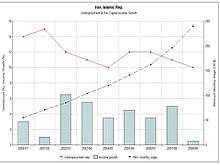
Iran is classed as a middle income country and has made significant progress in provision of health and education services in the period covered by the Millennium Development Goals (MDGs). In 2010, Iran's average monthly income was about $500 (GNI per capita in 2012: $13,000 by PPP).[38][177][178][179] A minimum national wage applies to each sector of activity as defined by the Supreme Labor Council. In 2009 this was about $263 per month ($3,156 per year).[180] The World Bank reported that in 2001, approximately 20% of household consumption was spent on food, 32% on fuel, 12% on health care and 8% on education.[181] Iranians have little debt.[182] Seventy percent of Iranians own their homes.[183]
According to the Statistical Centre of Iran, median household income of Iran in the fiscal year of 2018–2019 was 434,905,000 rials (a bit above $3,300), an 18.6% rise from the previous yearlong period of 2017–2018, where median household income was about 366,700,000 rials.[184] Adjusted for purchasing power parity, Iran's 2017–2018 median income was equivalent to about $28,647 (2017 conversion factor, private consumption, LCU).[185] As the average Iranian household size is 3.5, this puts median personal income at around $8,185.[186] While Iran rates relatively well on income, median wealth is very low for its income level (on par with Vietnam or Djibouti), indicating a high level of spending. According to SCI, median household spending in the 2018–2019 fiscal year was 393,227,000 rials, or 90.5% of the median household income of 434,905,000 rials.[184]
After the Revolution, the composition of the middle class in Iran did not change significantly, but its size doubled from about 15% of the population in 1979 to more than 32% in 2000.[187] The official poverty line in Tehran for the year ending March 20, 2008, was $9,612, while the national average poverty line was $4,932.[188] In 2010, Iran's Department of Statistics announced that 10 million Iranians live under the absolute poverty line and 30 million live under the relative poverty line.[189]
Social security
Although Iran does not offer universal social protection, in 1996, the Iranian Center for Statistics estimated that more than 73% of the Iranian population was covered by social security.[190] Membership of the social security system for all employees is compulsory.[191]
Social security ensures employee protection against unemployment, disease, old age and occupational accidents.[192] In 2003, the government began to consolidate its welfare organizations to eliminate redundancy and inefficiency. In 2003 the minimum standard pension was 50% of the worker's earnings but no less than the minimum wage.[192] Iran spent 22.5% of its 2003 national budget on social welfare programs of which more than 50% covered pension costs.[193] Out of the 15,000 homeless in Iran in 2015, 5,000 were women.[194]
Employees between the age of 18 and 65 years are covered by the social security system with financing shared between the employee (7% of salary), the employer (20–23%) and the state, which in turn supplements the employer contribution up to 3%.[195] Social security applies to self-employed workers, who voluntarily contribute between 12% and 18% of income depending on the protection sought.[192] Civil servants, the regular military, law enforcement agencies, and IRGC have their own pension systems.[196]
Trade unions
Although Iranian workers have a theoretical right to form labor unions, there is no union system in the country. Ostensible worker representation is provided by the Workers' House, a state-sponsored institution that attempts to challenge some state policies.[197] Guild unions operate locally in most areas, but are limited largely to issuing credentials and licenses. The right to strike is generally not respected by the state. Since 1979 strikes have often been met by police action.[198]
A comprehensive law covers labor relations, including hiring of foreign workers. This provides a broad and inclusive definition of the individuals it covers, recognizing written, oral, temporary and indefinite employment contracts. Considered employee-friendly, the labor law makes it difficult to lay off staff. Employing personnel on consecutive six-month contracts (to avoid paying benefits) is illegal, as is dismissing staff without proof of a serious offense. Labor disputes are settled by a special labor council, which usually rules in favor of the employee.[191]
Sectors
Agriculture and foodstuffs
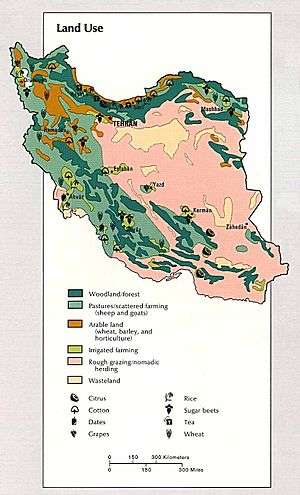
Agriculture contributes 9.5% to the gross domestic product and employs 17% of the labor force.[42] About 9% of Iran's land is arable,[199] with the main food-producing areas located in the Caspian region and in northwestern valleys. Some northern and western areas support rain-fed agriculture, while others require irrigation.[200] Primitive farming methods, overworked and under-fertilized soil, poor seed and water scarcity are the principal obstacles to increased production. About one third of total cultivated land is irrigated. Construction of multipurpose dams and reservoirs along rivers in the Zagros and Alborz mountains have increased the amount of water available for irrigation. Agricultural production is increasing as a result of modernization, mechanization, improvements to crops and livestock as well as land redistribution programs.[201]
Wheat, the most important crop, is grown mainly in the west and northwest. Rice is the major crop in the Caspian region. Other crops include barley, corn, cotton, sugar beets, tea, hemp, tobacco, fruits, potatoes, legumes (beans and lentils), vegetables, fodder plants (alfalfa and clover), almonds, walnuts and spices including cumin and sumac. Iran is the world's largest producer of saffron, pistachios, honey, berberis and berries and the second largest date producer.[202] Meat and dairy products include lamb, goat meat, beef, poultry, milk, eggs, butter, and cheese.
Non-food products include wool, leather, and silk. Forestry products from the northern slopes of the Alborz Mountains are economically important. Tree-cutting is strictly controlled by the government, which also runs a reforestation program. Rivers drain into the Caspian Sea and are fished for salmon, carp, trout, pike, and sturgeon that produce caviar, of which Iran is the largest producer.[201][203]
Since the 1979 revolution, commercial farming has replaced subsistence farming as the dominant mode of agricultural production. By 1997, the gross value reached $25 billion.[67] Iran is 90% self-sufficient in essential agricultural products, although limited rice production leads to substantial imports. In 2007 Iran reached self-sufficiency in wheat production and for the first time became a net wheat exporter.[204] By 2003, a quarter of Iran's non-oil exports were of agricultural products,[205] including fresh and dried fruits, nuts, animal hides, processed foods, and spices.[67] Iran exported $736 million worth of foodstuffs in 2007 and $1 billion (~600,000 tonnes) in 2010.[206] A total of 12,198 entities are engaged in the Iranian food industry, or 12% of all entities in the industry sector. The sector also employs approximately 328,000 people or 16.1% of the entire industry sector's workforce.[207]
Manufacturing
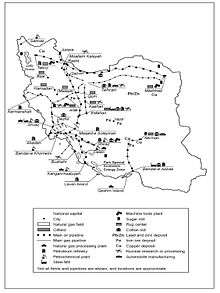
Large-scale factory manufacturing began in the 1920s. During the Iran–Iraq War, Iraq bombed many of Iran's petrochemical plants, damaging the large oil refinery at Abadan bringing production to a halt. Reconstruction began in 1988 and production resumed in 1993. In spite of the war, many small factories sprang up to produce import-substitution goods and materials needed by the military.[208]
Iran's major manufactured products are petrochemicals, steel and copper products. Other important manufactures include automobiles, home and electric appliances, telecommunications equipment, cement and industrial machinery. Iran operates the largest operational population of industrial robots in West Asia.[209] Other products include paper, rubber products, processed foods, leather products and pharmaceuticals. In 2000, textile mills, using domestic cotton and wool such as Tehran Patou and Iran Termeh employed around 400,000 people around Tehran, Isfahan and along the Caspian coast.[210][211]
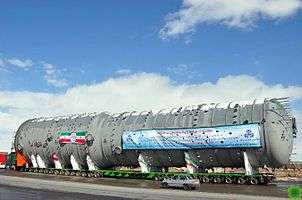
A 2003 report by the United Nations Industrial Development Organization regarding small and medium-sized enterprises (SMEs)[170] identified the following impediments to industrial development:
- Lack of monitoring institutions;
- Inefficient banking system;
- Insufficient research & development;
- Shortage of managerial skills;
- Corruption;
- Inefficient taxation;
- Socio-cultural apprehensions;
- Absence of social learning loops;
- Shortcomings in international market awareness necessary for global competition;
- Cumbersome bureaucratic procedures;
- Shortage of skilled labor;
- Lack of intellectual property protection;
- Inadequate social capital, social responsibility and socio-cultural values.
Despite these problems, Iran has progressed in various scientific and technological fields, including petrochemical, pharmaceutical, aerospace, defense, and heavy industry. Even in the face of economic sanctions, Iran is emerging as an industrialized country.[212]
Handicrafts

Iran has a long tradition of producing artisanal goods including Persian carpets, ceramics, copperware, brassware, glass, leather goods, textiles and wooden artifacts. The country's carpet-weaving tradition dates from pre-Islamic times and remains an important industry contributing substantial amounts to rural incomes. An estimated 1.2 million weavers in Iran produce carpets for domestic and international export markets.[213] More than $500 million worth of hand-woven carpets are exported each year, accounting for 30% of the 2008 world market.[214][215] Around 5.2 million people work in some 250 handicraft fields and contribute 3% of GDP.[216]
Automobile manufacturing
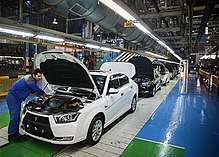
As of 2001, 13 public and privately owned automakers within Iran, led by Iran Khodro and Saipa that accounted for 94% of domestic production. Iran Khodro's Paykan, replaced by the Samand in 2005, is the predominant brand. With 61% of the 2001 market, Khodro was the largest player, whilst Saipa contributed 33% that year. Other car manufacturers, such as the Bahman Group, Kerman Motors, Kish Khodro, Raniran, Traktorsazi, Shahab Khodro and others accounted for the remaining 6%.[217] These automakers produce a wide range of vehicles including motorbikes, passenger cars such as Saipa's Tiba, vans, mini trucks, medium-sized trucks, heavy trucks, minibuses, large buses and other heavy automobiles used for commercial and private activities in the country. In 2009 Iran ranked fifth in car production growth after China, Taiwan, Romania and India.[218] Iran was the world's 12th biggest automaker in 2010 and operates a fleet of 11.5 million cars.[219][220][221][222] Iran produced 1,395,421 cars in 2010, including 35,901 commercial vehicles.[223]
Defense industry
In 2007 the International Institute for Strategic Studies estimated Iran's defense budget at $7.31 billion, equivalent to 2.6% of GDP or $102 per capita, ranking it 25th internationally. The country's defense industry manufactures many types of arms and equipment. Since 1992, Iran's Defense Industries Organization (DIO) has produced its own tanks, armored personnel carriers, guided missiles, radar systems, a guided missile destroyer, military vessels, submarines and a fighter plane.[224] In 2006 Iran exported weapons to 57 countries, including NATO members, and exports reached $100 million.[225][226][227] It has also developed a sophisticated mobile air defense system dubbed as Bavar 373.[228]
Construction and real estate
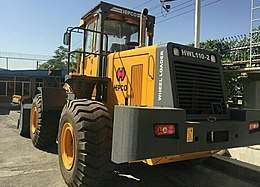
Until the early 1950s construction remained in the hands of small domestic companies. Increased income from oil and gas and easy credit triggered a building boom that attracted international construction firms to the country. This growth continued until the mid-1970s when a sharp rise in inflation and a credit squeeze collapsed the boom. The construction industry had revived somewhat by the mid-1980s, although housing shortages and speculation remained serious problems, especially in large urban centers. As of January 2011, the banking sector, particularly Bank Maskan, had loaned up to 102 trillion rials ($10.2 billion) to applicants of Mehr housing scheme.[229] Construction is one of the most important sectors accounting for 20–50% of total private investment in urban areas and was one of the prime investment targets of well-off Iranians.[193]
Annual turnover amounted to $38.4 billion in 2005 and $32.8 billion in 2011.[230][231] Because of poor construction quality, many buildings need seismic reinforcement or renovation.[232] Iran has a large dam building industry.[233]
Mines and metals

Mineral production contributed 0.6% of the country's GDP in 2011,[235] a figure that increases to 4% when mining-related industries are included. Gating factors include poor infrastructure, legal barriers, exploration difficulties, and government control over all resources.[236] Iran is ranked among the world's 15 major mineral-rich countries.[237]
Although the petroleum industry provides the majority of revenue, about 75% of all mining sector employees work in mines producing minerals other than oil and natural gas.[67] These include coal, iron ore, copper, lead, zinc, chromium, barite, salt, gypsum, molybdenum, strontium, silica, uranium, and gold, the latter of which is mainly a by-product of the Sar Cheshmeh copper complex operation.[235][238] The mine at Sar Cheshmeh in Kerman Province is home to the world's second largest store of copper.[239] Large iron ore deposits exist in central Iran, near Bafq, Yazd and Kerman. The government owns 90% of all mines and related industries and is seeking foreign investment.[236] The sector accounts for 3% of exports.[236]
Iran has recoverable coal reserves of nearly 1.9 billion short tonnes. By mid-2008, the country produced about 1.3 million short tonnes of coal annually and consumed about 1.5 million short tonnes, making it a net importer.[240] The country plans to increase hard-coal production to 5 million tons in 2012 from 2 million tons in November 2008.[241]
The main steel mills are located in Isfahan and Khuzestan. Iran became self-sufficient in steel in 2009.[242] Aluminum and copper production are projected to hit 245,000 and 383,000 tons respectively by March 2009.[241][243] Cement production reached 65 million tons in 2009, exporting to 40 countries.[243][244]
Petrochemicals
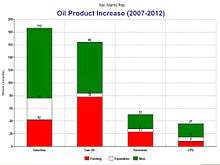
Iran manufactures 60–70% of its equipment domestically, including refineries, oil tankers, drilling rigs, offshore platforms, and exploration instruments.[245][246][247][248]
Based on a fertilizer plant in Shiraz, the world's largest ethylene unit, in Asalouyeh, and the completion of other special economic zone projects, Iran's exports in petrochemicals reached $5.5 billion in 2007, $9 billion in 2008 and $7.6 billion during the first ten months of the Iranian calendar year 2010.[249][250][251] National Petrochemical Company's output capacity will increase to over 100 million tpa by 2015 from an estimated 50 million tpa in 2010 thus becoming the world' second largest chemical producer globally after Dow Chemical with Iran housing some of the world's largest chemical complexes.[120]
Major refineries located at Abadan (site of its first refinery), Kermanshah and Tehran failed to meet domestic demand for gasoline in 2009. Iran's refining industry requires $15 billion in investment over the period 2007–2012 to become self-sufficient and end gasoline imports.[252] Iran has the fifth cheapest gasoline prices in the world leading to fuel smuggling with neighboring countries.[253]
Services
Despite 1990s efforts towards economic liberalization, government spending, including expenditure by quasi-governmental foundations, remains high. Estimates of service sector spending in Iran are regularly more than two-fifths of GDP, much government-related, including military expenditures, government salaries, and social security disbursements.[38] Urbanization contributed to service sector growth. Important service industries include public services (including education), commerce, personal services, professional services and tourism.
The total value of transport and communications is expected to rise to $46 billion in nominal terms by 2013, representing 6.8% of Iran's GDP.[254] Projections based on 1996 employment figures compiled for the International Labour Organization suggest that Iran's transport and communications sector employed 3.4 million people, or 20.5% of the labor force in 2008.[254]
Energy, gas, and petroleum
.svg.png)
Iran possesses 10% of the world's proven oil reserves and 15% of its gas reserves.[29] Domestic oil and gas along with hydroelectric power facilities provide power.[29] Energy wastage in Iran amounts to six or seven billion dollars per year,[255] much higher than the international norm.[95] Iran recycles 28% of its used oil and gas, whereas some other countries reprocess up to 60%.[255] In 2008 Iran paid $84 billion in subsidies for oil, gas and electricity.[35] It is the world's third largest consumer of natural gas after United States and Russia.[38] In 2010 Iran completed its first nuclear power plant at Bushehr with Russian assistance.[256]
Iran has been a major oil exporter since 1913. The country's major oil fields lie in the central and southwestern parts of the western Zagros mountains. Oil is also found in northern Iran and in the Persian Gulf. In 1978, Iran was the fourth largest oil producer, OPEC's second largest oil producer and second largest exporter.[257] Following the 1979 revolution the new government reduced production. A further decline in production occurred as result of damage to oil facilities during the Iraq-Iran war. Oil production rose in the late 1980s as pipelines were repaired and new Gulf fields exploited. By 2004, annual oil production reached 1.4 billion barrels producing a net profit of $50 billion.[258] Iranian Central Bank data show a declining trend in the share of Iranian exports from oil-products (2006/2007: 84.9%, 2007/2008: 86.5%, 2008/2009: 85.5%, 2009/2010: 79.8%, 2010/2011 (first three quarters): 78.9%).[259] Iranian officials estimate that Iran's annual oil and gas revenues could reach $250 billion by 2015 once current projects come on stream.[112]
Pipelines move oil from the fields to the refineries and to such exporting ports as Abadan, Bandar-e Mashur and Kharg Island. Since 1997, Iran's state-owned oil and gas industry has entered into major exploration and production agreements with foreign consortia.[260][261] In 2008 the Iranian Oil Bourse (IOB) was inaugurated in Kish Island.[262] The IOB trades petroleum, petrochemicals and gas in various currencies. Trading is primarily in the euro and rial along with other major currencies, not including the US dollar.[263] According to the Petroleum Ministry, Iran plans to invest $500 billion in its oil sector by 2025.[264]
On 15 November 2019, Iran raised the oil prices by 50 per cent and imposed a strict rationing system. The prices per litre gasoline rose to 15,000 riyals, where only 60 liters were permitted to private cars for a month. Besides, oil purchase beyond the limit would cost 30,000 riyals per litre. The policy changes came in effect to the US sanctions, and caused protests across the country. Protesters began to demand the ousting of President Hassan Rouhani.[265] The protests began to grow violent, where people began setting fire to public property. On November 17, the Iranian Supreme Leader Ayatollah Ali Khamenei called these protesters "thugs", amidst the talks with the clerics. He even signaled a potential crackdown, while the internet access was also shut down for the entire nation.[266]
Retail and distribution
Iran's retail industry consists largely of cooperatives (many of them government-sponsored), and independent retailers operating in bazaars. The bulk of food sales occur at street markets with prices set by the Chief Statistics Bureau. Iran has 438,478 small grocery retailers.[267] These are especially popular in cities other than Tehran where the number of hypermarkets and supermarkets is still very limited. More mini-markets and supermarkets are emerging, mostly independent operations. The biggest chainstores are state-owned Etka, Refah, Shahrvand and Hyperstar Market.[267] Electronic commerce in Iran passed the $1 billion mark in 2009.[268]
In 2012, Iranians spent $77 billion on food, $22 billion on clothes and $18.5 billion on outward tourism.[269] In 2015, overall consumer expenditures and disposable income are projected at $176.4 billion and $287 billion respectively.[270]
Healthcare and pharma
| IRAN: Healthcare (Source: EIU)[271] | 2005 | 2006 | 2007 | 2008 | 2009 | 2010 |
|---|---|---|---|---|---|---|
| Life expectancy, average (years) | 70.0 | 70.3 | 70.6 | 70.9 | 71.1 | 71.4 |
| Healthcare spending (% of GDP) | 4.2 | 4.2 | 4.2 | 4.2 | 4.2 | 4.2 |
| Healthcare spending ($ per head) | 113 | 132 | 150 | 191 | 223 | 261 |
The constitution entitles Iranians to basic health care. By 2008, 73% of Iranians were covered by the voluntary national health insurance system.[271] Although over 85% of the population use an insurance system to cover their drug expenses, the government heavily subsidizes pharmaceutical production/importation. The total market value of Iran's health and medical sector was $24 billion in 2002 and was forecast to rise to $50 billion by 2013.[272][273] In 2006, 55 pharmaceutical companies in Iran produced 96% (quantitatively) of the medicines for a market worth $1.2 billion.[271][274][275] This figure is projected to increase to $3.65 billion by 2013.[273]
Tourism and travel
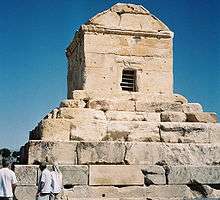
Although tourism declined significantly during the war with Iraq, it has subsequently recovered. About 1,659,000 foreign tourists visited Iran in 2004 and 2.3 million in 2009 mostly from Asian countries, including the republics of Central Asia, while about 10% came from the European Union and North America.[80][276][277]
The most popular tourist destinations are Mazandaran, Isfahan, Mashhad and Shiraz.[278] In the early 2000s the industry faced serious limitations in infrastructure, communications, industry standards and personnel training.[200] The majority of the 300,000 tourist visas granted in 2003 were obtained by Asian Muslims, who presumably intended to visit important pilgrimage sites in Mashhad and Qom.[277] Several organized tours from Germany, France and other European countries come to Iran annually to visit archaeological sites and monuments. In 2003 Iran ranked 68th in tourism revenues worldwide.[279] According to UNESCO and the deputy head of research for Iran Travel and Tourism Organization (ITTO), Iran is rated among the "10 most touristic countries in the world".[279] Domestic tourism in Iran is one of the largest in the world.[280]
Banking, finance and insurance
Government loans and credits are available to industrial and agricultural projects, primarily through banks. Iran's unit of currency is the rial which had an average official exchange rate of 9,326 rials to the U.S. dollar in 2007.[38] Rials are exchanged on the unofficial market at a higher rate. In 1979, the government nationalized private banks. The restructured banking system replaced interest on loans with handling fees, in accordance with Islamic law. This system took effect in the mid-1980s.[54]
The banking system consists of a central bank, the Bank Markazi, which issues currency and oversees all state and private banks. Several commercial banks have branches throughout the country. Two development banks exist and a housing bank specializes in home mortgages. The government began to privatize the banking sector in 2001 when licenses were issued to two new privately owned banks.[283]
State-owned commercial banks predominantly make loans to the state, bonyad enterprises, large-scale private firms and four thousand wealthy/connected individuals.[284][285] While most Iranians have difficulty obtaining small home loans, 90 individuals secured facilities totaling $8 billion.[286] In 2009, Iran's General Inspection Office announced that Iranian banks held some $38 billion of delinquent loans, with capital of only $20 billion.[287]
Foreign transactions with Iran amounted to $150 billion of major contracts between 2000 and 2007, including private and government lines of credit.[288] In 2007, Iran had $62 billion in assets abroad.[289] In 2010, Iran attracted almost $11.9 billion from abroad, of which $3.6 billion was FDI, $7.4 billion was from international commercial bank loans, and around $900 million consisted of loans and projects from international development banks.[290]
As of 2010, the Tehran Stock Exchange traded the shares of more than 330 registered companies.[282] Listed companies were valued at $100 billion in 2011.[291][292]
Insurance premiums accounted for just under 1% of GDP in 2008,[240] a figure partly attributable to low average income per head.[240] Five state-owned insurance firms dominate the market, four of which are active in commercial insurance. The leading player is the Iran Insurance Company, followed by Asia, Alborz and Dana insurances. In 2001/02 third-party liability insurance accounted for 46% of premiums, followed by health insurance (13%), fire insurance (10%) and life insurance (9.9%).[283]
Communications, electronics and IT
Broadcast media, including five national radio stations and five national television networks as well as dozens of local radio and television stations are run by the government. In 2008, there were 345 telephone lines and 106 personal computers for every 1,000 residents.[293] Personal computers for home use became more affordable in the mid-1990s, since when demand for Internet access has increased rapidly. As of 2010, Iran also had the world's third largest number of bloggers (2010).[294] In 1998, the Ministry of Post, Telegraph & Telephone (later renamed the Ministry of Information & Communication Technology) began selling Internet accounts to the general public. In 2006, revenues from the Iranian telecom industry were estimated at $1.2 billion.[295] In 2006, Iran had 1,223 Internet Service Providers (ISPs), all private sector operated.[296] As of 2014, Iran has the largest mobile market in the Middle East, with 83.2 million mobile subscriptions and 8 million smart-phones in 2012.[297]
According to the World Bank, Iran's information and communications technology sector had a 1.4% share of GDP in 2008.[293] Around 150,000 people work in this sector, including 20,000 in the software industry.[298] 1,200 IT companies were registered in 2002, 200 in software development. In 2014 software exports stood at $400 million.[299] By the end of 2009, Iran's telecom market was the fourth-largest in the Middle East at $9.2 billion and was expected to reach $12.9 billion by 2014 at a compound annual growth rate of 6.9%.[300]
Transport

Iran has an extensive paved road system linking most towns and all cities. In 2011, the country had 173,000 kilometres (107,000 mi) of roads, of which 73% were paved. In 2007 there were approximately 100 passenger cars for every 1,000 inhabitants.[219] Trains operated on 11,106 kilometres (6,901 mi) of track.[38]
The country's major port of entry is Bandar-Abbas on the Strait of Hormuz. After arriving in Iran, imported goods are distributed by trucks and freight trains. The Tehran–Bandar-Abbas railroad, opened in 1995, connects Bandar-Abbas to Central Asia via Tehran and Mashhad. Other major ports include Bandar Anzali and Bandar Torkaman on the Caspian Sea and Khoramshahr and Bandar Imam Khomeini on the Persian Gulf. Dozens of cities have passenger and cargo airports. Iran Air, the national airline, was founded in 1962 and operates domestic and international flights. All large cities have bus transit systems and private companies provide intercity bus services. Tehran, Mashhad, Shiraz, Tabriz, Ahvaz and Isfahan are constructing underground railways. More than one million people work in the transportation sector, accounting for 9% of 2008 GDP.[301]
International trade
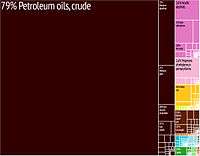
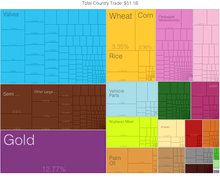
Iran is a founding member of OPEC and the Organization of Gas Exporting Countries.[302] Petroleum constitutes 56% of Iran's exports with a value of $60.2 billion in 2018.[18] For the first time, the value of Iran's non-oil exports is expected to reach the value of imports at $43 billion in 2011.[303] Pistachios, liquefied propane, methanol (methyl alcohol), hand-woven carpets and automobiles are the major non-oil exports.[304] Copper, cement, leather, textiles, fruits, saffron and caviar are also export items of Iran.
Technical and engineering service exports in 2007–08 were $2.7 billion of which 40% of technical services went to Central Asia and the Caucasus, 30% ($350 million) to Iraq, and close to 20% ($205 million) to Africa.[305] Iranian firms have developed energy, pipelines, irrigation, dams and power generation in different countries.[306] The country has made non-oil exports a priority[102] by expanding its broad industrial base, educated and motivated workforce and favorable location, which gives it proximity to an estimated market of some 300 million people in Caspian, Persian Gulf and some ECO countries further east.[307][308]
Total import volume rose by 189% from $13.7 billion in 2000 to $39.7 billion in 2005 and $55.189 billion in 2009.[309][310] Iran's major commercial partners are China, India, South Korea, Germany, Japan, France, Russia and Italy. From 1950 until 1978, the United States was Iran's foremost economic and military partner, playing a major role in infrastructure and industry modernization.[55][56] It is reported that around 80% of machinery and equipment in Iran is of German origin.[311] In July 2018, France, Germany and UK agreed to continue trade with Iran without using Dollar as a medium of exchange.[312] In March 2018, Iran had banned Dollar in trade.[313]
| Top Trading Partners for Iran for 2016[314] | |||||||||||||||||||||||||||||||||||||||||||||||||||||||||||||||||||||||||||||||||||||||||||||||||||||||||||
|---|---|---|---|---|---|---|---|---|---|---|---|---|---|---|---|---|---|---|---|---|---|---|---|---|---|---|---|---|---|---|---|---|---|---|---|---|---|---|---|---|---|---|---|---|---|---|---|---|---|---|---|---|---|---|---|---|---|---|---|---|---|---|---|---|---|---|---|---|---|---|---|---|---|---|---|---|---|---|---|---|---|---|---|---|---|---|---|---|---|---|---|---|---|---|---|---|---|---|---|---|---|---|---|---|---|---|---|
|
| ||||||||||||||||||||||||||||||||||||||||||||||||||||||||||||||||||||||||||||||||||||||||||||||||||||||||||
Since the mid-1990s, Iran has increased its economic cooperation with other developing countries in "south-south integration" including Syria, India, China, South Africa, Cuba and Venezuela. Iran's trade with India passed $13 billion in 2007, an 80% increase within a year.[315] Iran is expanding its trade ties with Turkey and Pakistan and shares with its partners the common objective to create a common market in West and Central Asia through ECO.[316]
Since 2003, Iran has increased investment in neighboring countries such as Iraq and Afghanistan. In Dubai, UAE, it is estimated that Iranian expatriates handle over 20% of its domestic economy and account for an equal proportion of its population.[317][318] Migrant Iranian workers abroad remitted less than $2 billion home in 2006.[319] Between 2005 and 2009, trade between Dubai and Iran tripled to $12 billion; money invested in the local real estate market and import-export businesses, collectively known as the Bazaar, and geared towards providing Iran and other countries with required consumer goods.[320] It is estimated that one third of Iran's imported goods and exports are delivered through the black market, underground economy, and illegal jetties, thus damaging the economy.[160]
Foreign direct investment
In the 1990s and early 2000s, indirect oilfield development agreements were made with foreign firms, including buyback contracts in the oil sector whereby the contractor provided project finance in return for an allocated production share. Operation transferred to National Iranian Oil Company (NIOC) after a set number of years, completing the contract.[321]
Unfavorable or complex operating requirements and international sanctions have hindered foreign investment in the country, despite liberalization of relevant regulations in the early 2000s. Iran absorbed $24.3 billion of foreign investment between the Iranian calendar years 1993 and 2007.[322] The EIU estimates that Iran's net FDI will rise by 100% between 2010 and 2014.[323]
Foreign investors concentrated their activities in the energy, vehicle manufacture, copper mining, construction, utilities, petrochemicals, clothing, food and beverages, telecom and pharmaceuticals sectors. Iran is a member of the World Bank's Multilateral Investment Guarantee Agency.[324] In 2006, the combined net worth of Iranian citizens abroad was about 1.3 trillion dollars.[325]
According to the head of the Organization for Investment, Economic and Technical Assistance of Iran (OIETAI), in 2008 Iran ranked 142 among 181 countries in working conditions. Iran stands at number 96 in terms of business start-ups, 165 in obtaining permits, 147 in employment, 147 in asset registration, 84 in obtaining credit, 164 in legal support for investments, 104 in tax payments, 142 in overseas trade, 56 in contract feasibility and 107 in bankruptcy.[326] Firms from over 50 countries invested in Iran between 1992 and 2008, with Asia and Europe the largest participants as shown below:[327]
| Continent of origin | Leading countries investing in Iran (1992–2008) | Number of projects | Total amount invested |
|---|---|---|---|
| Asia | India, United Arab Emirates (UAE), Singapore, Indonesia and Oman | 190 | $11.6 billion |
| Europe | Germany, the Netherlands, Spain, UK, Turkey, Italy and France (20 countries in total) | 253 | $10.9 billion |
| Americas | Canada, Panama, the US and Jamaica | 7 | $1.4 billion |
| Africa | Mauritius, Liberia and South Africa | N/A | $8 billion |
| Australia | Australia | 1 | $682 million |
The economic impact of a partial lifting of sanctions extends beyond the energy sector; The New York Times reported that "consumer-oriented companies, in particular, could find opportunity in this country with 81 million consumers, many of whom are young and prefer Western products".[328] The consumer-goods market is expected to grow by $100 billion by 2020.[329] Iran is considered "a strong emerging market play" by investment and trading firms.[330] Opening Iran's market place to foreign investment could also be a boon to competitive multinational firms operating in a variety of manufacturing and service sectors, worth $600 billion to $800 billion in new investment opportunities over the next decade.[331][332][333][334]
World Trade Organization
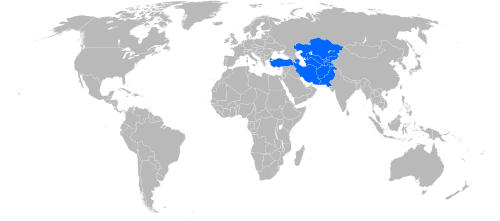
Iran has held observer status at the World Trade Organization (WTO) since 2005. Although the United States has consistently blocked its bid to join the organization, observer status came in a goodwill gesture to ease nuclear negotiations between Iran and the international community.[335] With exports of 60 products with revealed comparative advantage, Iran is the 65th "most complex country".[336]
Should Iran eventually gain membership status in the WTO, among other prerequisites, copyrights will have to be enforced in the country. This will require a major overhaul. The country is hoping to attract billions of dollars' worth of foreign investment by creating a more favorable investment climate through freer trade. Free trade zones such as Qeshm, Chabahar, and Kish Island are expected to assist in this process. Iran allocated $20 billion in 2010 to loans for the launch of twenty trade centers in other countries.[337]
International sanctions
After the Iranian Revolution in 1979, the United States ended its economic and diplomatic ties with Iran, banned Iranian oil imports and froze approximately $11 billion of its assets.[338] In 1996, the U.S. Government passed the Iran and Libya Sanctions Act (ILSA) which prohibits U.S. (and non-U.S.) companies from investing and trading with Iran in amounts of more than $20 million annually.[339] Since 2000 exceptions to this restriction have been made for items including pharmaceuticals and medical equipment.[340]
Iran's nuclear program has been the subject of contention with the West since 2006 over suspicions of its intentions. The UN Security Council imposed sanctions against select companies linked to the nuclear program, thus furthering the country's economic isolation.[341] The economic effects of sanctions have been severe.[342] Sanctions notably bar nuclear, missile and many military exports to Iran and target investments in oil, gas and petrochemicals, exports of refined petroleum products, as well as the Islamic Revolutionary Guard Corps, banks, insurance, financial transactions and shipping.[343] In 2012 the European Union tightened its own sanctions by joining the three decade-old US oil embargo against Iran.[344][345] In 2015, Iran and the P5+1 reached a deal on the nuclear program that will remove the main sanctions by early 2016.[346] Even though Iran can trade in its own currency some problems subsist mainly due to the fact that it cannot transact in US dollars freely.[347][348] Given its large reserves of oil and gas, the Iranian rial could become a world reserve currency if parity is established with oil and gas.[349]
In 2018, the United States government unilaterally withdrew from the JCPOA agreement and re-imposed its sanctions on Iran's oil sales, petrochemicals, shipping, metals trading and banking transactions.[350]
On 2 March 2020, India announced that its imports from Iran in January 2020 diminished by 97% comparing to January 2019. This came after the US refused to continue exemptions for customers of Iran's oil.[351]
Effects
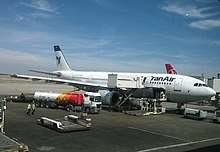
According to U.S. Undersecretary of State William Burns, Iran may be losing as much as $60 billion annually in energy investment.[352] Sanctions are making imports 24% more costly on average.[353] In addition, the latest round of sanctions could cost Iran annually $50 billion in lost oil revenues.[354] Iran is increasingly using barter trade because its access to the international dollar payment system has been denied. According to Iranian officials, large-scale withdrawal by international companies represents an "opportunity" for domestic companies to replace them.[355][356]
The IEA estimated that Iranian exports fell to a record of 860,000 bpd in September 2012 from 2.2 million bpd at the end of 2011. This fall led to a drop in revenues and clashes on the streets of Tehran when the local currency, the rial, collapsed. September 2012 output was Iran's lowest since 1988.[357]
The U.S. Energy Department has warned that imposing oil embargoes on Iran would increase world oil prices by widening the gap between supply and demand.[358] According to the U.S. Iran could reduce the world price of crude petroleum by 10%, saving the United States annually $76 billion (at the proximate 2008 world oil price of $100/bbl).[332]
According to NIAC, sanctions cost the United States over $175 billion in lost trade and 279,000 lost job opportunities.[359] Between 2010 and 2012, sanctions cost the E.U. states more than twice as much as the United States in terms of lost trade revenue. Germany was hit the hardest, losing between $23.1 and $73.0 billion between 2010–2012, with Italy and France following at $13.6-$42.8 billion and $10.9-$34.2 billion respectively.[359]
GDP growth turned negative in 2013 (−5%). The unofficial unemployment rate was 20% by mid-2012. Oil exports dropped to 1.4 million bpd in 2014 from 2.5 million bpd in 2011. By 2013, Iran had $80 billion in foreign exchange reserves frozen overseas. Automobile production declined 40% between 2011 and 2013.[360] According to the U.S. government in 2015, Iran's economy has reached a point where it is "fundamentally incapable of recovery" without a nuclear accommodation with the West.[361]
The tentative rapprochement between Iran and the US, which began in the second half of 2013, has the potential to become a world-changing development, and unleash tremendous geopolitical and economic opportunities, if it is sustained […] if Iran and the US were to achieve a diplomatic breakthrough, geopolitical tensions in the Middle East could decline sharply, and Iran could come to be perceived as a promising emerging market in its own right.[362]
In January 2019, President Hassan Rouhani blamed the US for Iran's declining economy. Following the US pullout from an international nuclear deal with Iran and re-imposed sanctions, Iran faced the toughest economic situation in 40 years.[363]
See also
- Corruption in Iran
- Electronic currency in Iran
- Energy superpower
- Foreign relations of Iran
- Iranian calendar
- Iran's international rankings in economy
- Iranian targeted subsidy plan
- Smuggling in Iran
- Venture capital in Iran
- Lists
- List of Iranians by net worth
- List of Iranian companies
- List of Iranian economists
- List of major economic laws in Iran
- Institutions
- Donya-e-Eqtesad – leading Iranian business newspaper
- Government of Iran – with links to ministries and affiliated agencies
- International Iranian Economic Association
- Iran Chamber of Commerce Industries and Mines – with links to information on commercial dispute resolution
- Ministry of Economic Affairs and Finance (Iran)
- Ministry of Industries and Business (Iran) – merger of Ministry of Commerce with Ministry of Industries and Mines
- Ministry of Petroleum (Iran)
- National Development Fund – Iran's sovereign wealth fund
- Ravand Institute – Iran's "Davos Forum"
- Supreme Audit Court of Iran
Notes
- Anthony H. Cordesman (September 23, 2008). "The US, Israel, the Arab States and a Nuclear Iran. Part One: Iranian Nuclear Programs" (PDF). Center for Strategic and International Studies. Retrieved September 25, 2010.
- "World Economic Outlook Database, April 2019". IMF.org. International Monetary Fund. Retrieved September 29, 2019.
- "World Bank Country and Lending Groups". datahelpdesk.worldbank.org. World Bank. Retrieved September 29, 2019.
- "Population, total – Iran, Islamic Rep". data.worldbank.org. World Bank. Retrieved September 30, 2019.
- "World Economic Outlook Database, October 2019". IMF.org. International Monetary Fund. Retrieved November 3, 2019.
- "World Economic Outlook Database, April 2020". IMF.org. International Monetary Fund. Retrieved April 18, 2020.
- "MIDDLE EAST :: IRAN". CIA.gov. Retrieved January 17, 2020.
- "Iخط فقر در ایران دامنهدارتر شده است". Deutsche Welle (in Persian).
- "Poverty headcount ratio at $5.50 a day (2011 PPP) (% of population) - Iran, Islamic Rep". data.worldbank.org. World Bank. Retrieved November 3, 2019.
- "Iran Gini-Koeffizient, 2017-2018 - knoema.com". Knoema (in German). Retrieved December 15, 2019.
- "Human Development Index (HDI)". hdr.undp.org. HDRO (Human Development Report Office) United Nations Development Programme. Retrieved December 11, 2019.
- "Inequality-adjusted HDI (IHDI)". hdr.undp.org. UNDP. Retrieved May 22, 2020.
- "Labor force, total – Iran, Islamic Rep". data.worldbank.org. World Bank. Retrieved November 3, 2019.
- "Employment to population ratio, 15+, total (%) (national estimate) – Iran, Islamic Rep". data.worldbank.org. World Bank. Retrieved November 3, 2019.
- "Iran Unemployment Rate". CEIC Data. Retrieved July 28, 2019.
- چکیده نتایج طرح آمارگیری هزینه و درامد خانوارهای شهری و روستایی - ۱۳۹۲ (PDF) (in Persian). Statistical Center of Iran. July 13, 2014. Archived (PDF) from the original on December 4, 2014. Retrieved December 4, 2014.
- "Ease of Doing Business in Iran, Islamic Rep". Doingbusiness.org. Retrieved January 25, 2017.
- "Iran facts and figures". OPEC. Retrieved July 28, 2019.
- "Iran". OEC. Retrieved July 28, 2019.
- "Iran Total Imports, 1979 - 2018". CEIC Data. Retrieved October 5, 2019.
- "Iran expected revenues based on exchange rate of USD1=IRR17,500". djavadsalehi.com. Retrieved May 20, 2020.
- Iles, Toby (March 5, 2014). Pat Thaker (ed.). "Iran: risk assessment". Economist Intelligence Unit. Retrieved March 28, 2014. Cite journal requires
|journal=(help) - "Iran Foreign reserves". IMF. Retrieved May 20, 2020.
- Iran privatizes $63bn of state assets. PressTV, November 29, 2009. Retrieved January 28, 2010.
- "A survey of Iran: Stunted and distorted". The Economist (2003)
- "Iran offers incentives to draw investors". PressTV. April 26, 2010. Archived from the original on March 10, 2012. Retrieved March 24, 2011.
- Matthew Lynn: Are you brave enough to invest in Iran?. Wall Street Journal (Market Watch), March 26, 2014. Retrieved March 28, 2014.
- Energy and the Iranian economy. United States Congress. July 25, 2006. ISBN 978-1-4223-2094-5. Retrieved June 11, 2014.
- Iran (data). US Department of Energy (2011). Retrieved March 28, 2011.
- Balamir Coşkun, Bezen (Winter 2009). "Global Energy Geopolitics and Iran" (PDF). Uluslararası İlişkiler. 5 (20): 179–201. Archived from the original (PDF) on April 1, 2014.
- Ramin Mostaghim, Alexandra Sandels and Patrick J. McDonnell: Iran businesses await a post-sanctions bonanza. Los Angeles Times, March 15, 2014. Retrieved March 28, 2014.
- Robert W. Jordan: Iran Could Become an Economic Superpower. Time Magazine, July 16, 2015. Retrieved July 31, 2015.
- Bonyad-e Mostazafan va Janbazan Oppressed and Disabled Veterans Foundation (MJF). Globalsecurity.org. Retrieved February 6, 2011.
- "U.S. targets Iran's vulnerable oil". Los Angeles Times. 2007. Retrieved July 17, 2007.
- "Energy subsidies reach $84b". Iran Daily. April 27, 2008. Archived from the original on June 19, 2009.
- Iran falls to 168 in Corruption Perception Index Archived November 22, 2009, at the Wayback Machine. Transparency International (2009). Retrieved November 19, 2009.
- Country Report. Freedom House (2007). Retrieved October 29, 2009.
- "World Factbook: Iran's entry". Central Intelligence Agency. 2008. Archived from the original on February 3, 2012. Retrieved November 6, 2009.

- "Islamic Republic of Iran. Overview". World Bank. May 1, 2020. Retrieved June 12, 2020.
- Iran oil exports top 844mn barrels. PressTV, June 16, 2010. Retrieved June 16, 2010.
- "Iran threatens new war games in the oil lanes of the Gulf". The Telegraph. January 6, 2012. Retrieved January 24, 2012.
- "Iran: Economic and Political Overview". Nordea. May 2020. Retrieved June 12, 2020.
- "Iran Economy 2020". theodora. Retrieved June 12, 2020.
- "Six charts that show how hard US sanctions have hit Iran". BBC News. December 9, 2019. Retrieved June 12, 2020.
- "2020 Index of Economic Freedom. Country Rankings". Heritage. Retrieved June 12, 2020.
- "Ease of Doing Business rankings". DOINGBUSINESS. May 2019. Retrieved June 12, 2020.
- Frances Harrison (January 8, 2007). "Huge cost of Iranian brain drain". BBC News.
- Gheissari, Ali (2009). Contemporary Iran: Economy, Society, Politics. USA: Oxford University Press. pp. 3–4 (Paperback edition). ISBN 978-0-19-537849-8.
- "Human Development Report 2014 – "Sustaining Human Progress: Reducing Vulnerabilities and Building Resilience"" (PDF). HDRO (Human Development Report Office) United Nations Development Programme. Retrieved August 8, 2014.
- "35 stunning photos of the most beautiful places in Iran". cnn.com. February 11, 2016. Retrieved March 28, 2018.
- "Gold coins – A Brief History". Retrieved February 16, 2014.
- "Monetary Episodes from History". Retrieved February 16, 2014.
- "History of Banking in Iran". Parstimes.com. Retrieved November 11, 2012.
- Curtis, Glenn; Hooglund, Eric (April 2008). Iran, a country study. Washington, D.C., USA: Library of Congress. p. 195. ISBN 978-0-8444-1187-3.
- Iran's Industrial Progresses (Part I) on YouTube. Iran National Film Centre (circa 1975). Retrieved January 20, 2010.
- Iran's Industrial Progresses (Part II) on YouTube. Iran National Film Centre (circa 1975). Retrieved January 20, 2010.
- Shirin Hakimzadeh. Iran: A Vast Diaspora Abroad and Millions of Refugees at Home. Migration information source (2006). Retrieved July 18, 2009.
- "Iran-Iraq war". Microsoft Encarta. 2008.
- Iran–Iraq war (1980–1988). Globalsecurity.org. Retrieved October 21, 2009.
- "Iranian Economy in Six Snapshots". Payam-e Emruz; Economic, Social, Cultural (Monthly). February 2001. Archived from the original on September 27, 2007.
- Gheissari, Ali (2009). Contemporary Iran: Economy, Society, Politics. USA: Oxford University Press. pp. 7–8 (Paperback edition). ISBN 978-0-19-537849-8.
- Country Reports – Iran. UNESCO (2000). Retrieved February 5, 2011.
- Iranian unemployment rate not reduced to target. PressTV, January 26, 2010. Retrieved January 26, 2010.
- Table H United Nations Development Programme (2009). Retrieved February 5, 2011.
- Science in Iran: An Islamic Science Revolution?. Science Magazine, September 16, 2005 (subscription required). Retrieved November 15, 2008.
- Reza Malekzadeh, Azarakhsh Mokri, Pejman Azarmina: "Medical Science and Research in Iran". Academy of Medical Sciences of Iran. Retrieved December 4, 2008.
- – The foreign trade regime of the Islamic Republic of Iran. Ministry of Commerce (Iran) (2009). Retrieved April 8, 2010.
- Iran ranks first in scientific growth Archived January 9, 2012, at the Wayback Machine. PressTV, December 31, 2011. Retrieved January 7, 2012.
- Iran ranks 17th in science production in 2012 . PressTV, January 2, 2013. Retrieved February 3, 2013.
- Judith Evans: Fund managers on the Iranian frontier. Financial Times, March 1, 2015. Retrieved April 29, 2016.
- "Iran 39th Industrialized Country". Archived from the original on June 30, 2009. Retrieved May 1, 2010.CS1 maint: BOT: original-url status unknown (link). The Economist, May 27, 2009.
- "Iran advances 41 places in industrial production". Tehran Times. February 28, 2010. Archived from the original on August 20, 2012. Retrieved May 10, 2010.
- Iran's GDP to grow by $55.5B. The Economist, April 6, 2010. Retrieved April 7, 2010.
- Iran at a glance. Economist Intelligence Unit (subscription required), December 12, 2011. Retrieved January 8, 2012.
- Ali Akbar Dareini: Iran Leader Unveils 'Economy of Resistance'. Archived 2014-02-27 at the Wayback Machine Associated Press, February 19, 2014. Retrieved February 19, 2014.
- Economic survey reveals Iran's slowdown. Radio Zamaneh, December 26, 2012. Retrieved February 3, 2013.
- Leader: Imports, Contraband Inflicting Damage on Iran’s Economy. Tasnim News Agency, February 23, 2015. Retrieved February 28, 2015
- Javier Blas: Sanctions take heavy toll on Iran. Financial Times, November 28, 2012 (subscription required). Retrieved February 3, 2013.
- Jbili, A.; Kramarenko, V.; Bailén, J. M. (March 1, 2007). Islamic Republic of Iran: Managing the Transition to a Market Economy (PDF). The International Monetary Fund. p. xii. ISBN 978-1-58906-441-6. Retrieved February 5, 2011.
- "Iran's entry". Microsoft Encarta. 2008. Archived from the original on October 28, 2009. Retrieved July 24, 2010.
- The Global Competitiveness Report (2014–2015). World Economic Forum, August 2014. Retrieved September 5, 2014.
- Iran Investment Monthly. Archived December 9, 2013, at the Wayback Machine Turquoise Partners, September 2013. Retrieved December 6, 2013.
- Iran ranks 69th out of 139 in global competitiveness Archived December 9, 2013, at the Wayback Machine. Global Competitiveness Report, World Economic Forum (2010). Retrieved September 18, 2010.
- Banks become Iran’s economic nightmare. PressTV, August 21, 2016. Retrieved August 21, 2016.
- "The N-11: More Than an Acronym" Archived September 11, 2008, at the Wayback Machine. Goldman Sachs, March 28, 2007. Retrieved February 6, 2011.
- Iran Ranks 3rd Among Newly-Emerged Economies Archived June 17, 2011, at the Wayback Machine. Zawaya, October 26, 2010. Retrieved October 26, 2010.
- Iran eyes 'constructive engagement—but not with Israel. CNBC, January 23, 2014. Retrieved February 1, 2014.
- World Economic Outlook Database (Iran). International Monetary Fund (October 2014). Retrieved February 16, 2015.
- Full Text of the Law for the Targeting of Subsidies. Princeton University, November 2009. Retrieved February 16, 2016.
- Roshanak Taghavi (April 30, 2010). "Why Iran's Ahmadinejad is pushing to cut popular government subsidies". CSMonitor.com. Retrieved May 5, 2010.
- Iran Investment Monthly Archived August 9, 2011, at the Wayback Machine. Turquoise Partners (January 2011). Retrieved January 31, 2011.
- "Iran – Country Brief". World Bank. September 2010. Archived from the original on February 10, 2011. Retrieved January 30, 2010.
- Planned Economic Reforms Archived May 13, 2011, at the Wayback Machine. Atieh Bahar (2008). Retrieved May 24, 2009.
- Iran to Cut Oil Subsidies in Energy Reform. International Monetary Fund, September 28, 2010. Retrieved October 13, 2010.
- Reza Taghizadeh (June 9, 2010): Sanctions And Iran's Achilles Heel. Radio Free Europe. Retrieved October 13, 2010.
- Iran Investment Monthly Archived December 14, 2010, at the Wayback Machine. Turquoise Partners (October 2010). Retrieved October 30, 2010.
- The fifth Iranian development plan. PressTV, January 19, 2010. Retrieved January 20, 2010.
- Ayse, Valentine; Nash, Jason John; Leland, Rice (January 2013). The Business Year 2013: Iran. London, U.K.: The Business Year. p. 41. ISBN 978-1-908180-11-7. Archived from the original on December 27, 2016. Retrieved March 14, 2014.
- World Economic Outlook Database – Report for Selected Countries and Subjects. International Monetary Fund (2009). Retrieved November 29, 2010.
- Iran to be world's 12th economy in 2015 Archived January 19, 2011, at the Wayback Machine. PressTV, December 24, 2010. Retrieved December 25, 2010.
- 'Iran to notch up highest growth in 2015'.PressTV, March 31, 2011. Retrieved April 18, 2014.
- Iran five-year plan targets annual 8% growth. Agence France Presse, January 11, 2010. Retrieved July 23, 2010.
- Iran approves $1.6b of foreign investment plans Archived April 25, 2012, at the Wayback Machine. Tehran Times, April 21, 2012. Retrieved April 21, 2012.
- Iran Commercial Banking Report Archived February 13, 2012, at the Wayback Machine. Business Monitor International (Q1 2009). Retrieved July 10, 2010.
- Cracks Start to Show in Iran's Economy as U.S. Touts Sanctions. Foxnews, December 27, 2010. Retrieved December 27, 2010.
- Prices in Iran rise after lifting of subsidies. Los Angeles Times, December 23, 2010. Retrieved December 27, 2010.
- Iran Investment Monthly Archived March 6, 2012, at the Wayback Machine. Turquoise Partners (December 2010). Retrieved December 27, 2010.
- Iran to privatize 186 state-run companies: official Archived May 28, 2014, at the Wayback Machine. Tehran Times, May 11, 2014. Retrieved May 27, 2014.
- Cooperatives Share Meager in Economy. Financial Tribune, May 9, 2015. Retrieved May 10, 2015.
- Invest in Iran. Organization for Investment, Economic and Technical Assistance of Iran, Winter 2011. Retrieved March 28, 2014.
- Iran plans $160 billion annual trade turnover by 2016 Archived May 27, 2012, at the Wayback Machine. Tehran Times, May 23, 2012. Retrieved June 3, 2012.
- Iran eyes $250 billion annual revenue in 5 years. Mehr News Agency, December 22, 2010. Retrieved December 22, 2010.
- 2010 Staff report. IMF (March 2010). Retrieved December 27, 2010.
- Iran’s NDF allocates $7b to upstream oil projects Archived July 14, 2014, at the Wayback Machine. Tehran Times, July 9, 2014. Retrieved July 12, 2014.
- Iran sets up biggest PG oil platform Archived October 18, 2011, at the Wayback Machine. PressTV, October 18, 2011. Retrieved October 18, 2011.
- Oil Minister: Iran Self-Sufficient in Drilling Industry Archived June 6, 2013, at the Wayback Machine. Fars News Agency, January 9, 2012. Retrieved February 5, 2012.
- Iran to up gas production capacity Archived January 9, 2011, at the Wayback Machine. PressTV, January 1, 2011. Retrieved January 6, 2011.
- Oil Industry Will Carry Out 380 Research Projects. Iran Daily, April 12, 2012. Retrieved April 13, 2012.
- South Pars attracts $15b in domestic investment. Mehr News Agency, June 15, 2010. Retrieved June 15, 2010.
- Iran to build 46 new petchem units. Tehran Times, January 13, 2010. Retrieved January 30, 2010.
- $44b investment for 64 petchem projects. Tehran Times, November 23, 2010. Retrieved November 23, 2010.
- Bunkering Sector Flourishing. Iran Daily, October 26, 2010. Retrieved October 25, 2010.
- Iran to open biggest oil refinery in ME Archived January 20, 2012, at the Wayback Machine. PressTV, January 28, 2011. Retrieved January 30, 2011.
- Iran to store South Pars gas underground Archived April 30, 2012, at the Wayback Machine. PressTV, April 27, 2012. Retrieved April 30, 2012.
- Iran to boost power generation capacity by 25,000MW. Tehran Times, October 26, 2011. Retrieved October 30, 2011.
- Iran Top Producer of Hydroelectric Power Plants. Zawya, April 14, 2011. Retrieved October 7, 2011.
- Mining Sector Exports Hit $8b. Iran Daily, July 4, 2010. Retrieved July 10, 2010.
- Economy, News. National Geoscience Database of Iran (2010). Retrieved July 24, 2010.
- Ports Capacity to Increase. Iran Daily, December 27, 2010. Retrieved December 26, 2010.
- Iran to extend rail network to 15,000 kilometers by 2015 Archived February 4, 2012, at the Wayback Machine. Tehran Times, January 3, 2012. Retrieved January 3, 2012.
- Transportation. Organization for Investment and Technical Assistance of Iran, 2012. Retrieved March 14, 2014.
- 'Iran cargo transit revenue to hit $12 bn' Archived October 9, 2012, at the Wayback Machine. PressTV, April 30, 2011. Retrieved March 14, 2014.
- Electronic trade up. Iran Daily, October 6, 2011. Retrieved October 6, 2011.
- Kordvani, Amir; Berenjforoush, Poulad. "Iran approves the Sixth Development Plan to boost investment". lexology. Retrieved June 13, 2020.
- "Overview". World Bank. Retrieved October 21, 2017.
- "Iran Inflation Rate". Index Mondi. 2009. Retrieved February 5, 2011.
- "Crude price pegged at dlrs 39.6 a barrel under next year's budget". IRNA, January 27, 2008. Retrieved December 5, 2008.
- Iran's entry. Foreign and CommonWealth Office (2010). Retrieved June 21, 2009.
- Iran's parliament approves $462 billion budget Archived July 18, 2013, at the Wayback Machine. Associated Press. Retrieved May 19, 2012.
- Ten Million Iranians Under "Absolute Poverty Line". Radio Zamaneh. Retrieved May 5, 2011.
- Experts: Steinitz exaggerates on Iran economy. The Jerusalem Post, April 10, 2012. Retrieved April 18, 2012.
- Najmeh Bozorgmehr: Subsidy dispute adds to Iran’s woes. Financial Times, April 25, 2012 (subscription required). Retrieved April 25, 2012.
- Minister: Iran Facing No Problem in Currency Reserves, Revenues Archived April 19, 2012, at the Wayback Machine. Fars News Agency, April 18, 2012. Retrieved May 2, 2012.
- The Oil and Gas Industry. Iran Primer (PBS), October 26, 2010. Retrieved October 27, 2010.
- Marjorie Olster (August 23, 2013). "Sanctions Biting but Iran Not Budging". AP. Retrieved August 24, 2013.
- Iran's external debts cut by $10b, hit $7.2b: Central Bank Chief. Tehran Times, May 27, 2013. Retrieved August 24, 2013.
- Iran: Concluding Statement of an IMF Staff Visit. IMF, October 3, 2016. Retrieved October 10, 2016.
- Filkins, Dexter (May 18, 2020). "The Twilight of the Iranian Revolution". The New Yorker.
|access-date=requires|url=(help) - Iran Investment Monthly. Turquoise Partners, May 2016. Retrieved December 15, 2016.
- Katy Barnato: Iranians to splash up to $8B on overseas property: Study. CNBC, March 16, 2016. Retrieved December 15, 2016.
- Ten Million Iranians Under "Absolute Poverty Line". Radio Zamaneh, May 29, 2010. Retrieved December 15, 2016.
- Decentralization key to solving economic problems. Iran Daily, July 12, 2014. Retrieved July 12, 2014.
- 6,000 Cooperatives Nationwide. Iran Daily, July 12, 2012. Retrieved July 14, 2012.
- Iranian Constitution. University of Bern (2010). Retrieved February 2, 2011.
- "Call for Prioritizing Vision 2025". Archived from the original on February 17, 2009. Retrieved February 13, 2012.CS1 maint: BOT: original-url status unknown (link). Iran Daily, February 12, 2009.
- Justice Shares Payment Soon. Iran Daily, December 23, 2008. Retrieved July 23, 2010.
- "BBC Persian" (in Persian). BBC. January 16, 2006. Retrieved July 17, 2007.
- Minister predicts high rate of firm closures. Mehr News Agency, February 17, 2014. Retrieved March 4, 2014.
- Ahmadinejad slams corrupt hoarders of wealth: "The Iranian 1%". Radio Zamaneh, December 15, 2012. Retrieved March 16, 2014.
- Wehrey, Frederic (2009): "The Rise of the Pasdaran". RAND Corporation. Retrieved June 10, 2010.
- Iran's Guards in $2.5bn rail deal. BBC, November 11, 2009. Retrieved November 12, 2009.
- "Profile: Iran's Revolutionary Guards". BBC News. October 26, 2007. Retrieved December 27, 2008.
- Kim Murphy (August 26, 2007). "Iran's $12-billion enforcers". Los Angeles Times. Retrieved December 27, 2008.
- Azadeh Moaveni (September 5, 2007). "Iran's Rich Revolutionary Guard". Time. Retrieved December 27, 2008.
- Michael Slackman (July 20, 2009). "Hard-Line Force Extends Grip Over a Splintered Iran". The New York Times. Retrieved July 21, 2009.
- Abrahamian, History of Modern Iran (p.178). Cambridge University Press (2008), ISBN 978-0-521-52891-7
- Abbas Bakhtiar: "Ahmadinejad's Achilles Heel: The Iranian Economy". Payvand, January 25, 2007. Retrieved February 12, 2008.
- Ilias, Shayerah (June 2008). "Iran's Economy" (PDF). U.S. Congressional Research Service. Cite journal requires
|journal=(help) - Stecklow, Steve; Dehghanpisheh, Babak; Torbati, Yeganeh (November 11, 2013). "Assets of the Ayatollah". Reuters. Retrieved December 7, 2013.
- Iran's Small and Medium Enterprises. The United Nations Industrial Development Organization (2003). Retrieved February 2, 2010.
- "National adult literacy rates (15+), youth literacy rates (15–24) and elderly literacy rates (65+)". UNESCO Institute for Statistics. Retrieved December 18, 2013.
- Nash, Jason John; Sasmaz, Aytng (January 2011). The Business Year 2011: Iran. London, U.K.: The Business Year. p. 232. ISBN 978-1-908180-00-1.
- "Gov't Set to Change Economic Course". Archived from the original on May 5, 2009. Retrieved July 6, 2008.CS1 maint: BOT: original-url status unknown (link). Iran Daily, June 24, 2008.
- Valentine M. Moghadam (2009). Where Are Iran's Working Women?. The Middle East Institute. Retrieved February 3, 2011.
- Emanuele Ottolenghi:Toppling Iran's Unsteady Regime. The Wall Street Journal, July 23, 2012. Retrieved July 24, 2012.
- Bloated Public Sector Criticized. Financial Tribune, December 28, 2016. Retrieved December 29, 2016.
- Iran’s per capita income exceeds $13,000: minister. Mehr News Agency, May 8, 2012. Retrieved April 18, 2014.
- Inside Story – Iran's economic surgery (Motion picture). Iran: AljazeeraEnglish. December 2010. Event occurs at 02:50. Retrieved December 28, 2010.
...in a country where the average income is around 500 dollars
- Iran Data by country: Iran, Islamic Rep Archived June 20, 2013, at the Wayback Machine. World Bank (2011). Retrieved February 5, 2011.
- Iran's Poor Face a Logjam in the Labyrinths of Work. ILNA.ir, October 21, 2009. Retrieved January 24, 2010.
- Iran – Income. Encyclopedia of the Nations. Retrieved October 14, 2010.
- Fitch, Asa; Nicolas Parasie (April 6, 2015). "Western Companies See Potential in Reaching Iran's Consumers After Nuclear Deal". Wall Street Journal. Retrieved April 10, 2015.
- "70% of Population Own Homes". Archived from the original on February 19, 2008. Retrieved April 9, 2007.CS1 maint: BOT: original-url status unknown (link). Iran Daily, April 9, 2007.
- Iran household spending up by almost 20 percent: Government data. Press TV. August 25, 2019.
- PPP conversion factor, private consumption (LCU per international $). World Bank. Accessed September 21, 2019. Conversion factor was 12800.39.
- Household size and Composition Around the World 2017. The United Nations. Page 18.
- Curtis, Glenn; Hooglund, Eric (April 2008). Iran, a country study. Washington, D.C., USA: Library of Congress. p. 104. ISBN 978-0-8444-1187-3.
- 29–33% of Iranians live below poverty line. PressTV, June 6, 2009. Retrieved June 7, 2009.
- Ten Million Iranians Under "Absolute Poverty Line". Radio Zamaneh, May 29, 2010. Retrieved May 28, 2010.
- "Iran: Country Brief". World Bank. 2009. Archived from the original on February 10, 2011. Retrieved July 12, 2009. Cite journal requires
|journal=(help) - Rouznameh, Rasmi (1990). "Labour Code". International Labour Organization. Retrieved March 1, 2009.
- Iran's entry. U.S. Social Security Administration. Retrieved October 14, 2010.
- "Annual Review". Central Bank of Iran. December 2009. Retrieved May 10, 2010.
- Women now comprise one-third of homeless Iranians. Radio Zamaneh, July 12, 2015. Retrieved July 14, 2015.
- Social Security Programs Throughout the World: Asia and the Pacific. Social Security Administration, 2004. Retrieved March 14, 2014.
- Iran – The pension system in Iran Archived November 30, 2011, at the Wayback Machine. World Bank (2003). Retrieved February 3, 2011.
- Iran's entry. International Labour Organization (2001). Retrieved February 3, 2011.
- Iran's New Labor? Frontline (PBS), January 28, 2010. Retrieved February 3, 2011.
- "Arable land (% of land area) | Data". data.worldbank.org. Retrieved May 10, 2018.
- Curtis, Glenn; Hooglund, Eric (April 2008). Iran, a country study. Washington, D.C., USA: Library of Congress. p. 354. ISBN 978-0-8444-1187-3.
- "Islamic Republic of Iran – Services for Agriculture and Rural Development". World Bank. June 1994. Archived from the original (PDF) on July 23, 2008. Retrieved March 28, 2011. Cite journal requires
|journal=(help) - Commodities by country – Iran Archived July 13, 2011, at the Wayback Machine. FAO Statistics (2010). Retrieved January 30, 2010.
- Business | Crunch time for Caspian caviar. BBC News, June 19, 2001. Retrieved January 30, 2010.
- "Trade With PGCC To Improve". Archived from the original on March 7, 2008. Retrieved December 3, 2008.CS1 maint: BOT: original-url status unknown (link). Iran Daily, December 31, 2007.
- The Case Study of The Islamic Republic of Iran. World Bank, June 10, 2004. Retrieved April 7, 2008.
- "Iran's foodstuff exports near $1b". Tehran Times. February 24, 2010. Retrieved January 21, 2012.
- Ayse, Valentine; Nash, Jason John; Leland, Rice (January 2013). The Business Year 2013: Iran. London, U.K.: The Business Year. p. 82. ISBN 978-1-908180-11-7. Archived from the original on December 27, 2016. Retrieved March 14, 2014.
- Iran's Defense Industry. Globalsecurity.org. Retrieved February 3, 2011.
- IFRstat.org. United Nations Economic Commission for Europe, October 11, 2005. Retrieved July 23, 2010.
- "Textile Smuggling Harms Domestic Production". Retrieved June 1, 2016.. Iran Daily, July 1, 2009.
- "Textile factories in trouble". Archived from the original on October 18, 2007. Retrieved June 2, 2010.CS1 maint: BOT: original-url status unknown (link). Iran Daily, January 15, 2007.
- Torbat, Akbar (September 27, 2010). "Industrialization and Dependency: the Case of Iran". Economic Cooperation Organization. Archived from the original on July 26, 2011. Retrieved February 5, 2011.CS1 maint: unfit url (link)
- "Iran to form carpet export consortium". PressTV. November 9, 2008. Archived from the original on March 25, 2012. Retrieved March 1, 2009.
- "Health Insurance for Carpet Weavers". Archived from the original on June 3, 2009. Retrieved December 16, 2008.. Iran Daily, December 16, 2008.
- Iran’s oldest craft left behind. Financial Times, February 10, 2010 (subscription required). Retrieved February 10, 2009.
- Iran's Handicrafts. PressTV, January 6, 2010. Retrieved January 10, 2010.
- "Iran Automotive Industry". Archived from the original on June 17, 2008. Retrieved May 29, 2011.. Atieh Bahar (2003).
- "Iran Ranks 5th in Car Production Growth". Fars News Agency. August 18, 2010. Archived from the original on March 1, 2012. Retrieved November 28, 2010. Cite journal requires
|journal=(help) - "Iran Automotive Forecast". Economist Intelligence Unit. 2008.
- "Iran 16th Biggest Automaker". Archived from the original on October 17, 2007. Retrieved June 12, 2007.. Iran Daily, June 12, 2007.
- "Gasoline Quota Will Change In Two Months". Archived from the original on October 20, 2007. Retrieved July 4, 2007.CS1 maint: BOT: original-url status unknown (link). Iran Daily, July 4, 2007.
- Iran ranks 2nd in using gas-fueled cars. Tehran Times, September 20, 2010. Retrieved November 29, 2010.
- "Iran ranks 5th on OICA growth chart". PressTV. August 18, 2010. Archived from the original on October 15, 2010. Retrieved November 28, 2010. Cite journal requires
|journal=(help) - Iran Launches Production of Stealth Sub Archived February 8, 2011, at the Wayback Machine. Associated Press, May 10, 2005. Retrieved February 13, 2008.
- "IRI exports warfare to 50 countries". Archived from the original on February 13, 2008. Retrieved July 20, 2010.CS1 maint: BOT: original-url status unknown (link). IRIB, April 23, 2005.
- "Iran exports military equipment". Archived from the original on September 27, 2007. Retrieved July 20, 2010.CS1 maint: BOT: original-url status unknown (link). IRIB, September 3, 2006.
- Advanced attack chopper joins Iran fleet. PressTV, May 24, 2009. Retrieved May 24, 2009.
- "Iran Nearing Production of Indigenous S-300 Missile System". Fars News Agency. September 22, 2011. Retrieved September 6, 2015.
- $10b Allocated for Mehr Housing. Iran Daily, January 13, 2011. Retrieved April 3, 2011.
- "Construction in Iran". Archived from the original on March 6, 2007. Retrieved March 6, 2007.CS1 maint: BOT: original-url status unknown (link). Australian Trade (2007).
- Iran Infrastructure Report. Business Monitor International (Q1 2011). Retrieved March 22, 2011.
- "Housing for All". Archived from the original on June 15, 2009. Retrieved August 11, 2014.CS1 maint: BOT: original-url status unknown (link). Iran Daily, April 13, 2009.
- "Simultaneous Dam, Spillways Construction Obligatory – 30% Drinking Water Wasted". Archived from the original on October 20, 2007. Retrieved November 29, 2006.CS1 maint: BOT: original-url status unknown (link). Iran Daily, November 29, 2006.
- Monthly Bulletin Archived March 18, 2012, at the Wayback Machine. Tehran Stock Exchange (June 2010). Retrieved April 4, 2011.
- Iran's mineral exports up 39 percent Archived September 1, 2011, at the Wayback Machine. PressTV (2011). Retrieved February 3, 2011.
- "Mining to Iran". Australian Government. 2007. Archived from the original on July 23, 2008. Retrieved February 5, 2011.
- "Mining in Iran". InfoMine. Retrieved October 18, 2011.
- Philip M. Mobbs (2004): The mineral industry of Iran. Parstimes. Retrieved February 3, 2011.
- Curtis, Glenn; Hooglund, Eric (April 2008). Iran, a country study. Washington, D.C., USA: Library of Congress. p. 167. ISBN 978-0-8444-1187-3.
- "Energy and Electricity Forecast". Economist Intelligence Unit. 2008. Cite journal requires
|journal=(help) - Iran Plans to Produce 250,000 Tons of Copper in Year to March. Bloomberg, November 28, 2008. Retrieved November 28, 2008.
- "Steel Self-sufficiency". Archived from the original on April 14, 2011. Retrieved July 23, 2010.CS1 maint: BOT: original-url status unknown (link). Iran Daily, June 11, 2009.
- Iran: $30 Billion Dollar to be invested in industry. IRNA, November 15, 2008. Retrieved November 15, 2008.
- Iran exports cement to 40 countries. Tehran Times, February 8, 2010. Retrieved October 31, 2010.
- "Dehloran Refinery Under Construction". Archived from the original on March 29, 2011. Retrieved July 23, 2010.CS1 maint: BOT: original-url status unknown (link). Iran Daily, November 9, 2008.
- "Company Advances In Energy Capabilities". Archived from the original on October 20, 2007. Retrieved February 7, 2012.. Iran Daily, April 29, 2007.
- Iran Ready for Sudden Cut in Gas Supplies. Fars News Agency, July 14, 2010. Retrieved July 26, 2010.
- Share of domestically made equipments on the rise Archived March 9, 2012, at the Wayback Machine. SHANA, July 18, 2010. Retrieved July 26, 2010.
- Iran opens world largest ethylene unit. PressTV, December 7, 2008. Retrieved June 5, 2009.
- Iran exports $570M of petrochemicals. PressTV, April 26, 2008. Retrieved June 5, 2009.
- Petrochemical Exports Pass $7 Billion Archived February 6, 2011, at the Wayback Machine. SHANA, January 31, 2011. Retrieved March 23, 2011.
- Iran's oil refining industry needs dlrs 15b investment: Oil Minister. IRNA, February 17, 2007. Retrieved October 16, 2008.
- Iran Investment Monthly. Turquoise Partners (July 2014). Retrieved August 16, 2014.
- Rail-Freight Transport. Iran Daily, June 12, 2007. Retrieved February 12, 2008. February 4, 2011.
- Energy Wastage In Iran Equals 6–7 Billion Dollars Per Year. IRNA, October 29, 2008. Retrieved November 2, 2008.
- "Iran set to build more nuclear plants". PressTV. March 1, 2009. Archived from the original on December 21, 2013. Retrieved March 1, 2009.
- Iran's Economy. Parstimes. Retrieved September 24, 2010.
- Barry Schweid (December 26, 2006): Iran oil industry founders Archived May 13, 2007, at the Wayback Machine. Associated Press. Retrieved February 12, 2008.
- Iranian National Bank. "Economic Trends No 62, Third Quarter 1389 (2010/2011), Balance of Payments, p.16".
- Curtis, Glenn; Hooglund, Eric (April 2008). Iran, a country study. Washington, D.C., USA: Library of Congress. pp. 160–163. ISBN 978-0-8444-1187-3.
- Wolfensberger, Marc (November 25, 2006). "Iran Invites Sinopec Head to Sign $100 Billion Oil, Gas Deals". Bloomberg. Archived from the original on February 6, 2007. Retrieved November 20, 2010.
- 1st phase of Iran oil stock inaugurated on Kish Island. IRNA, February 17, 2008.
- Oil bourse opens in Iran's Kish Island. PressTV, February 17, 2008. Retrieved February 17, 2008.
- "$500b Needed For Hydrocarbon Sector". Archived from the original on October 7, 2008. Retrieved September 2, 2012.CS1 maint: BOT: original-url status unknown (link). Iran Daily, April 24, 2008.
- "Oil Price Hike Out of Economic Crisis Result in Protests Across Iran". True News Source. Retrieved November 16, 2019.
- "Iran's leader calls demonstrators 'thugs' as protests spread to 100 cities". The US Breaking News. Retrieved November 17, 2019.
- "Retailing in Iran". Euromonitor. January 2010. Retrieved November 28, 2010.
- Iran's e-commerce to reach rls 10,000 billion. IRNA, December 3, 2008.
- Fitch, Asa; Nicolas Parasie (April 6, 2015). "Western Companies See Potential in Reaching Iran's Consumers After Nuclear Deal". Wall Street Journal. Retrieved April 9, 2015.
- Faucon, Benoit (July 15, 2015). "In Iran, Business Deals Rarely Smooth". Wall Street Journal. Retrieved July 27, 2015.
- "IRAN: Healthcare and Pharmaceuticals Forecast". Economist Intelligence Unit. 2008. Cite journal requires
|journal=(help) - "Health Sector in Iran". Archived from the original on April 19, 2008. Retrieved March 6, 2007.CS1 maint: BOT: original-url status unknown (link). Australian Trade (2006).
- Iran Pharmaceuticals and Healthcare Report. Business Monitor International (Q2 2009). Retrieved March 24, 2010.
- "Health services and pharmaceuticals to Iran". Archived from the original on April 19, 2008. Retrieved March 6, 2007.CS1 maint: BOT: original-url status unknown (link). Australian Trade (2006).
- "18% of Medicines Thrown Out Annually". Archived from the original on October 18, 2007. Retrieved June 30, 2007.. Iran Daily, July 1, 2007.
- "Iran Travel And Tourism Forecast". Economist Intelligence Unit. 2008. Cite journal requires
|journal=(help) - Iran hosted 2.3 million tourists this year. PressTV, March 19, 2010. Retrieved March 22, 2011.
- Sightseeing and excursions in Iran Archived April 18, 2015, at the Wayback Machine. Tehran Times, September 28, 2010. Retrieved March 22, 2011.
- Iran ranks 68th in tourism revenues worldwide. Payvand/IRNA, September 7, 2003. Retrieved February 12, 2008.
- Ayse, Valentine; Nash, Jason John; Leland, Rice (January 2013). The Business Year 2013: Iran. London, U.K.: The Business Year. p. 166. ISBN 978-1-908180-11-7. Archived from the original on December 27, 2016. Retrieved March 14, 2014.
- Iran blocks share price gains. BBC, August 6, 2003. Retrieved February 15, 2010.
- "Tehran Exchange Trades Futures to Attract Investors". BusinessWeek. July 26, 2010. Archived from the original on May 14, 2011. Retrieved July 29, 2010.
- "Iran Financial Services Forecast". Economist Intelligence Unit. 2008. Cite journal requires
|journal=(help) - "Banking System Needs Overhaul". Archived from the original on December 10, 2008. Retrieved October 10, 2008.CS1 maint: BOT: original-url status unknown (link). Iran Daily, October 7, 2008.
- "President in Birjand Rally". Archived from the original on December 12, 2008. Retrieved October 10, 2008.CS1 maint: BOT: original-url status unknown (link). Iran Daily, October 9, 2008.
- In Iran, 90 people owe $8 billion to banks. PressTV, August 23, 2009.
- USD 38 billion delinquent loans to Iranian banks Archived February 4, 2010, at the Wayback Machine. PressTV, October 9, 2009. Retrieved April 23, 2011.
- "Global Investment in Iran". Archived from the original on January 5, 2010. Retrieved January 9, 2012.CS1 maint: BOT: original-url status unknown (link). American Enterprise Institute (2007).
- Iran’s foreign assets surpass $62b Archived January 19, 2008, at the Wayback Machine. Mehr News Agency, June 30, 2007. Retrieved January 23, 2008.
- Iran Investment Monthly Archived July 21, 2013, at the Wayback Machine. Turquoise Partners (August 2011). Retrieved January 31, 2011.
- TSE ranked as best bourse index Archived April 14, 2011, at the Wayback Machine. PressTV, February 1, 2011. Retrieved February 1, 2011
- "Vast Economic Potential Lauded". Archived from the original on December 12, 2008. Retrieved October 10, 2008.CS1 maint: BOT: original-url status unknown (link). Iran Daily, October 9, 2008.
- ICT At-a-Glance, Iran's entry Archived July 27, 2008, at the Wayback Machine. World Bank (login required). Retrieved February 4, 2011.
- Hackers take Iran's civil war online. Jerusalem Post, February 6, 2010. Retrieved February 6, 2011
- "Privatization of Telecom Companies". Archived from the original on February 19, 2008. Retrieved February 6, 2016.. Iran Daily, October 9, 2006.
- "Information and communications technology to Iran". Archived from the original on July 27, 2008. Retrieved May 9, 2009.CS1 maint: BOT: original-url status unknown (link). Australian Trade (2006).
- Iran's Mobile Market: Connectivity in 2014. "Innovation Is Everywhere". Retrieved July 15, 2014.
- Iran. Economist Intelligence Unit (2006). Retrieved December 5, 2008.
- Iran exports 400 million dollars of software products Archived March 5, 2014, at the Wayback Machine. PressTV, February 27, 2014. Retrieved August 11, 2014.
- Susan J. Campbell, Dearbhla McHenry (January 22, 2010): "Iran Telecom Market Expected to Reach $12.9 Billion by 2014". TMCnet/Pyramid Research. Retrieved January 24, 2010.
- Road Construction Projects Upbeat. Iran Daily, December 21, 2008. Retrieved July 23, 2010.
- Iran to Join Gas Exporters Club Soon Archived March 29, 2012, at the Wayback Machine. Fars News Agency, January 17, 2010. Retrieved January 22, 2010.
- VP predicts Iran’s non-oil trade balance would reach zero next year. Mehr News Agency, December 31, 2011. Retrieved January 19, 2012.
- Iran to launch more trade counselors. PressTV, October 25, 2008. Retrieved October 25, 2008.
- Engineering Service Exports Improve. Iran Daily November 24, 2008. Retrieved July 23, 2010.
- "Iran's trade not limited to Europe". PressTV. April 13, 2010. Archived from the original on April 7, 2012. Retrieved May 5, 2010.
- An Overview of the Economy of the Islamic Republic of Iran Archived August 6, 2010, at the Wayback Machine. United Nations Industrial Development Organization (UNIDO). Retrieved September 24, 2010.
- "Population in ECO Member States". Economic Cooperation Organization. Archived from the original on January 20, 2012. Retrieved September 28, 2010.CS1 maint: unfit url (link)
- Nader Habibi (May 5, 2005): "The Cost of Economic Sanctions on Major Exporters to Iran". Payvand. Retrieved January 23, 2008.
- Iran's non-oil exports stand at $21.321bn. PressTV, April 7, 2010. Retrieved April 7, 2010.
- German businesses should seize lucrative opportunities in Iran: NUMOV CEO Archived August 10, 2014, at the Wayback Machine. Tehran Times, July 19, 2014. Retrieved July 24, 2014.
- "EU's Big Three agree to establish dollarless trade with Iran – Lavrov". RT International. Retrieved July 13, 2018.
- "Iran bans use of US dollar in trade". RT International. Retrieved July 13, 2018.
- http://trade.ec.europa.eu/doclib/docs/2006/september/tradoc_113392.pdf
- $13bn: new record in Iran-India trade. PressTV, November 1, 2008. Retrieved November 2, 2008.
- Iran pres. to attend ECO summit Archived October 12, 2012, at the Wayback Machine. PressTV, December 15, 2010. Retrieved February 3, 2011.
- "Domestic Economy (Islamic WTO proposed)". Archived from the original on October 17, 2007. Retrieved December 3, 2006.CS1 maint: BOT: original-url status unknown (link). Iran Daily, January 22, 2006.
- "In 2005: Import Bill From Dubai $28.7b". Archived from the original on February 19, 2008. Retrieved December 16, 2008.. Iran Daily, April 4, 2006.
- "Overseas Workers Remit Over $2b". Archived from the original on February 25, 2008. Retrieved June 2, 2010.CS1 maint: BOT: original-url status unknown (link). Iran Daily, October 22, 2007.
- Kambiz Foroohar (January 25, 2010): "Dubai Helps Iran Evade Sanctions as Smugglers Ignore U.S. Laws" Archived March 21, 2010, at the Wayback Machine. Bloomberg. Retrieved January 26, 2010.
- "Iran – Oil and gas". Archived from the original on September 28, 2007. Retrieved September 28, 2007.. Atieh Bahar Consulting (2003).
- Iran attracted $24.3 billion foreign capital in 16 years. Mehr News Agency, May 27, 2007. Retrieved January 23, 2008.
- The tragicomedy of Iran sanctions. Aljazeera, May 22, 2010. Retrieved May 22, 2010.
- Dr. Amuzegar, Jahangir (March 20, 2005). "Iran's Third Development Plan: an Appraisal". Archived from the original on November 29, 2011. Retrieved July 26, 2010.
- "Expats Worth $1.3 Trillion". Archived from the original on December 30, 2007. Retrieved March 30, 2007.. Iran Daily, February 14, 2007.
- "Working Conditions to Improve". Archived from the original on June 3, 2009. Retrieved November 8, 2008.. Iran Daily, November 9, 2008.
- "$34b Foreign Investment in 16 years". Archived from the original on December 10, 2008. Retrieved February 19, 2016.. Iran Daily, December 7, 2008.
- Clifford Krauss, A New Stream of Oil for Iran, but Not Right Away, The New York Times (July 14, 2015).
- John Letzing (July 15, 2016). "P&G's Road Map to Business in Iran". Wall Street Journal. p. B1.
- Clifford Krauss: A New Stream of Oil for Iran, but Not Right Away The New York Times, July 14, 2015. Retrieved September 18, 2015.
- Asa Fitch: Post-Sanctions Iran Could Be A Turkey-Size Win for Investors. The Wall Street Journal, March 12, 2014. Retrieved March 13, 2014.
- Dean A. DeRosa & Gary Clyde Hufbauer: "Normalization of Economic Relations". (U.S.) National Foreign Trade Council. November 21, 2008. Retrieved March 30, 2012.
- Jason Rezaian: U.S. investors begin to imagine a return to Iran. The Washington Post, May 28, 2014. Retrieved June 1, 2014.
- Jay Solomon (July 1, 2014). "Oil, Auto Companies Make Plans to Invest in Iran if Sanctions Ease". Wall Street Journal. Retrieved July 5, 2014.
- "WTO Membership". Archived from the original on February 15, 2008. Retrieved April 9, 2010.CS1 maint: BOT: original-url status unknown (link). Iran Daily, April 15, 2007.
- Atlas: Iran. M.I.T (The Observatory of Economic Complexity). Retrieved December 15, 2016.
- Iran Plans to Open Trade Centers Abroad Archived March 1, 2012, at the Wayback Machine. Fars News Agency, January 16, 2010. Retrieved January 18, 2010.
- Suzanne Maloney (2010): "The Revolutionary Economy". United States Institute of Peace. Retrieved November 17, 2010.
- Kenneth Katzman (2003): "The Iran-Libya Sanctions Act (ILSA)" Archived December 19, 2016, at the Wayback Machine. CRS Report for Congress. Retrieved January 23, 2008.
- U.S. Approved Business With Blacklisted Nations. The New York Times, December 23, 2010 (subscription required). Retrieved February 2, 2011.
- Farnaz Fassihi: Iran's Economy Feels Sting of Sanctions. The Wall Street Journal, October 12, 2010. Retrieved October 13, 2010.
- Oryoie, Alireza; Abbasinejad, Hossien (2017). "The Rise and Fall of Top Incomes in Iran 1985-2015". Iranian Economic Review. 21 (4): 941–968. doi:10.22059/ier.2017.64104.
- Iran nuclear talks back on, in Geneva next week. Agence France Presse (AFP), November 30, 2010. Retrieved December 2, 2010.
- "Exclusive: EU agrees to embargo on Iranian crude". Reuters. January 2012. Retrieved September 28, 2012.
- "EU Embargo on Iran Oil Takes Effect". The Wall Street Journal. July 1, 2012. Retrieved September 28, 2012.
- Bijan Khajehpour: Preventing Iran's post-sanctions job crisis Archived August 11, 2016, at the Wayback Machine. Al-Monitor, July 17, 2015. Retrieved July 27, 2015.
- Jay Salomon (October 8, 2016). "Obama Further Eases Financial Sanctions On Iran News". The Wall Street Journal. Retrieved October 9, 2016.
- Iran, Pakistan agree to ditch dollar. PressTV, August 31, 2016. Retrieved September 13, 2016.
- "Sanctions Buster? Iran Eyes Cryptocurrency To Blunt U.S. Deterrents". www.payvand.com.
- https://www.bbc.com/news/world-middle-east-46075179
- Iran's Trade Dropped Dramatically In January Compared With 2019
- Flavia Krause-Jackson (December 1, 2010). "Sanctions Cost Iran $60 Billion in Oil Investments, Burns Says". Bloomberg. Archived from the original on September 1, 2012. Retrieved February 13, 2012.
- Iran admits the pain of sanctions Archived February 11, 2012, at the Wayback Machine. Agence France Presse (AFP), December 19, 2011. Retrieved January 7, 2012.
- Una Galani: (March 30, 2012) Sanctions could cost Iran $50 bln. Reuters. Retrieved March 30, 2012.
- Sanctions an 'opportunity' for local companies: Iran Archived March 18, 2013, at the Wayback Machine. Agence France Presse (AFP), October 14, 2010. Retrieved March 30, 2012.
- Sanctions should be taken as opportunity: Larijani. Tehran Times, September 30, 2010. Retrieved March 30, 2012.
- "IEA: Iran's oil exports fell, may slip further". The Jerusalem Post. Reuters. October 12, 2012. Retrieved October 14, 2012.
- Oil sanctions on Iran to worsen global market: US. Archived January 6, 2013, at the Wayback Machine PressTV, October 29, 2012. Retrieved November 11, 2012.
- Iran sanctions cost U.S. over $175b in lost trade: study Archived July 26, 2014, at the Wayback Machine. Tehran Times, July 15, 2014. Retrieved July 24, 2014.
- Mark Glassman: What Sanctions Have Done to Iran's Economy. Bloomberg LLP, March 2, 2015. Retrieved March 3, 2015.
- Solomon, Jay; Mauldin, William (February 1, 2015), "U.S. Treasury's Sanctions Czar Says Iran, Russia, Islamic State Weakened", Wall Street Journal, retrieved February 7, 2015
- "Iran-US Rapprochement: Historic Opportunities Beckon". Business Monitor International. January 10, 2014. Archived from the original on May 21, 2014.
- "Iran Faces Worst Economic Challenge in 40 Years, President Says". The New York Times. Retrieved January 30, 2019.
- Iran devalued its currency in July 2013
- includes publicly guaranteed debt
General references
- Articles
- Khajehpour, Bijan (August 9, 2019). "Can Iran combat corruption in petroleum sector?". Al-Monitor. Retrieved February 2, 2020.
- Saki, M.A. (March 5, 2019). "Blind subsidy system costing economy greatly". Tehran Times. Retrieved June 21, 2019.
- "Why Fuel Is Smuggled Out Of Iran And Why No One Stops It". Radio Farda. February 21, 2019. Retrieved July 18, 2019.
- Hossein-Zadeh, Ismael (November 9, 2018). "Why Iran Needs a War Economy". Payvand.com. Retrieved December 22, 2018.
- Khajehpour, Bijan (July 17, 2015). "Preventing Iran's post-sanctions job crisis". Atieh Group. Al-Monitor. Archived from the original on August 11, 2016. Retrieved July 27, 2015.
- Khajehpour, Bijan (April 10, 2015). "How the nuclear deal will help Iran's economy". Atieh Group. Al-Monitor. Retrieved April 12, 2015.
- "Iran's Neoliberal Austerity-Security Budget". Hooshang Amirahmadi. Payvand.com. February 16, 2015. Retrieved February 21, 2015.
- Khajehpour, Bijan (January 8, 2015). "Iran's new budget to focus on privatization, subsidy reforms". Atieh Group. Al-Monitor. Retrieved February 2, 2015.
- Khan, Jeremy (August 17, 2014). "Iran Lures Investors Anticipating Nuclear Deal May End Sanctions". Bloomberg News. Retrieved August 20, 2014.
- Stecklow, Steve; Dehghanpisheh, Babak; Torbati, Yeganeh (November 11, 2013). "Assets of the Ayatollah". Reuters. Retrieved December 7, 2013.
- "Iran's bold economic reform – Economic jihad". The Economist. June 23, 2011. Retrieved April 7, 2012.
- Behdad, Sohrab (October 25, 2010). "Where Did Iran's Islamic Economy Come From and Where Did it Go?". Payvand.com. Retrieved October 25, 2010.
- Askari, Hossein (August 26, 2008). "Iran's economic self-mutilation". Asia Times Online. Retrieved October 18, 2010.
- "Ambitious modernization program for the Tehran Stock Exchange". Global Investment House. June 22, 2007. Archived from the original on November 15, 2012. Retrieved October 18, 2010.
- Higgins, Andrew (June 2, 2007). "Inside Iran's Holy Money Machine". The Wall Street Journal. Archived from the original on March 14, 2016. Retrieved July 23, 2014.
- "Still failing, still defiant". The Economist. December 9, 2004. Retrieved July 23, 2014.
- Klebnikov, Paul (July 21, 2003). "Millionaire Mullahs". Forbes. Retrieved March 16, 2008.
- Books
- Suzanne, Maloney (June 2015). Iran's Political Economy since the Revolution. New York, USA: Cambridge University Press. ISBN 978-0-521-73814-9.
- Amuzegar, Jahangir (October 2014). The Islamic Republic of Iran: Reflections on an Emerging Economy. New York, USA: Routledge. ISBN 978-1-85743-748-5.
- Parvin, Alizadeh; Hakimian, Hassan (December 2013). Iran and the Global Economy: Petro Populism, Islam and Economic Sanctions. London, U.K.: Routledge. ISBN 978-1-315-86720-5.
- Ayse, Valentine; Nash, Jason John; Leland, Rice (January 2013). The Business Year 2013: Iran. London, U.K.: The Business Year. ISBN 978-1-908180-11-7. Archived from the original on March 27, 2015.
- Nash, Jason John; Sasmaz, Aytng (January 2011). The Business Year 2011: Iran. London, U.K.: The Business Year. ISBN 978-1-908180-00-1. Archived from the original on April 17, 2014.
- Gheissari, Ali (April 2009). Contemporary Iran: Economy, Society, Politics. New York, USA: Oxford University Press. ISBN 978-0-19-537849-8.
- Wehrey, Frederic (2009). The Rise of the Pasdaran: Assessing the Domestic Roles of Iran's Islamic Revolutionary Guards Corps (PDF). Santa Monica, California, USA: RAND Corporation. ISBN 978-0-8330-4620-8.
- Curtis, Glenn; Hooglund, Eric (April 2008). Iran, a country study. Washington, D.C., USA: Library of Congress. ISBN 978-0-8444-1187-3.
- Jbili, A.; Kramarenko, V.; Bailén, J. M. (March 2007). Islamic Republic of Iran: Managing the Transition to a Market Economy (PDF). International Monetary Fund. ISBN 978-1-58906-441-6.
- Mohammadi, Ali (April 2003). Iran encountering globalization: problems and prospects. London, U.K.: Routledge. ISBN 978-0-415-30827-4.
- Parvin, Alizadeh; Hakimian, Hassan (March 2001). The Economy of Iran: Dilemmas of an Islamic State. London, U.K.: I. B. Tauris. ISBN 978-1-86064-464-1.
- Homa, Katouzian (1981). The Political Economy of Modern Iran: Despotism and Pseudo-Modernism, 1926–1979. London, U.K.: Macmillan Publishers. ISBN 978-1-349-04778-9.
- Governments
- "Annual Review 2013/14" (PDF). Central Bank of Iran. February 2015. Cite journal requires
|journal=(help) - "Annual Review 2012/13" (PDF). Central Bank of Iran. July 2014. Cite journal requires
|journal=(help) - "A Review of the Iranian Tax System". Organization for Investment Economic and Technical Assistance of Iran. January 2014. Archived from the original on September 7, 2014.
- Katzman, Kenneth (January 2014). "Iran Sanctions" (PDF). U.S. Congressional Research Service. Cite journal requires
|journal=(help) - "Memorandum of the foreign trade regime of Iran" (PDF). Ministry of Commerce (Iran). November 2009. Archived from the original (PDF) on July 13, 2011. Cite journal requires
|journal=(help) - Ilias, Shayerah (June 2008). "Iran's Economy" (PDF). U.S. Congressional Research Service. Cite journal requires
|journal=(help) - Austrade (2006). "Doing Business in Iran". Archived from the original on May 25, 2006. Cite journal requires
|journal=(help) - Ministry of Commerce (Iran) (2004). "The National Report on E-Commerce in Iran" (PDF). Archived from the original (PDF) on April 27, 2006. Cite journal requires
|journal=(help) - Management and Planning Organization of Iran (2004). "Millennium Development Goals" (PDF). United Nations. Archived from the original (PDF) on November 28, 2007. Cite journal requires
|journal=(help)
- Papers
- "Science, Technology and Innovation Policy Review – The Islamic Republic of Iran" (PDF). United Nations Conference on Trade and Development. 2016. Retrieved December 7, 2016. Cite journal requires
|journal=(help) - "Iran: Concluding Statement of an IMF Staff Visit". International Monetary Fund. October 3, 2016. Retrieved December 12, 2016.
- "Entrepreneurship Ecosystem in Iran" (PDF). Iran Entrepreneurship Association. Winter 2014. Archived from the original (PDF) on September 13, 2015. Cite journal requires
|journal=(help) - IMF Staff Report (April 2014). "Islamic Republic of Iran" (PDF). International Monetary Fund. Cite journal requires
|journal=(help) - "Investment Guide To Iran". Atieh Bahar Consulting. February 2014. Archived from the original on March 17, 2014. Cite journal requires
|journal=(help) - "Regional Economic Outlook: Middle East and Central Asia" (PDF). International Monetary Fund. April 2011. Cite journal requires
|journal=(help) - "Regional Economic Outlook: Middle East and Central Asia" (PDF). International Monetary Fund. October 2010. Cite journal requires
|journal=(help) - Salehi-Isfahani, Djavad (September 2010). "Iranian Youth in Times of Economic Crisis" (PDF). The Dubai Initiative. Cite journal requires
|journal=(help) - IMF Staff Report (March 2010). "Islamic Republic of Iran" (PDF). International Monetary Fund. Cite journal requires
|journal=(help) - "Economic Prospects for the Middle East and North Africa Region" (PDF). World Bank. January 2010. Cite journal requires
|journal=(help) - "Normalization of Economic Relations: Consequences for Iran's Economy and the United States" (PDF). (US) National Foreign Trade Council. 2008. Cite journal requires
|journal=(help) - "The N-11: More Than an Acronym" (PDF). Goldman Sachs. March 2007. Archived from the original (PDF) on March 31, 2010. Cite journal requires
|journal=(help) - "Science, Technology and Innovation Policy Review – The Islamic Republic of Iran" (PDF). United Nations Conference on Trade and Development. February 2005. Cite journal requires
|journal=(help) - "Small and Medium Enterprises in Iran" (PDF). United Nations Industrial Development Organization. 2003. Cite journal requires
|journal=(help) - Nichols, Brian; Sahay, Sundeep (2003). "Building Iran's Software Industry" (PDF). University of Manchester.
- "Islamic Republic of Iran – Services for Agriculture and Rural Development". World Bank. June 1994. Archived from the original (PDF) on July 23, 2008. Cite journal requires
|journal=(help)
- Videos
- Iran Today (August 2016). The Iranian economy after the JCPOA (Webcast). Tehran, Iran: PressTV.
- Iran Today (August 2015). A look at Iran's 6th development plans (Webcast). Tehran, Iran: PressTV.
- Iran Today (August 2014). Iran government's economic fight (Webcast). Tehran, Iran: PressTV. Archived from the original on September 1, 2014.
- Iran Today (August 2014). Boosting international trade in Iran (Webcast). Tehran, Iran: PressTV. Archived from the original on August 21, 2014.
- Iran Today (March 2014). Leader urges serious pursuit of 'resistance economy' (Webcast). Tehran, Iran: PressTV. Archived from the original on March 4, 2016.
- Iran Today (October 2013). Latest on Iran's subsidy reform plan (Webcast). Tehran, Iran: PressTV. Archived from the original on December 14, 2013.
- Iran Today (July 2012). Iran's economy under sanctions (Webcast). Tehran, Iran: PressTV. Archived from the original on August 5, 2012.
- Iran Today (May 2012). Iran's "Economy of Resistance" (Webcast). Tehran, Iran: PressTV. Archived from the original on June 3, 2012.
- Iran Today (May 2012). Iran's New Commercial Law on a Five-Year Trial run (Webcast). Tehran, Iran: PressTV. Archived from the original on May 5, 2012.
- Iran Today (April 2012). 1391: Year of National Production, Supporting Iranian Capital and Labor (Webcast). Tehran, Iran: PressTV. Archived from the original on April 7, 2012.
- Iran Today (December 2011). Iran's economic overhaul (Webcast). Tehran, Iran: PressTV. Archived from the original on January 4, 2012.
- Iran Today (August 2011). Iran's economic development plan (Webcast). Tehran, Iran: PressTV. Archived from the original on August 22, 2011.
- Iran Today (April 2011). 2011: Year of "Economic Jihad" (Webcast). Tehran, Iran: PressTV. Archived from the original on October 9, 2011.
- Iran Today (March 2011). Iran's Budget Bill (FY 2011) (Webcast). Tehran, Iran: PressTV. Archived from the original on July 23, 2011.
- Iran Today (December 2010). Iran's Economic Reform Plan (Webcast). Tehran, Iran: PressTV. Archived from the original on January 19, 2011.
- Iran Today (November 2010). Fifth Development Plan in Majlis (Webcast). Tehran, Iran: PressTV. Archived from the original on January 19, 2011.
- Karim Sadjadpour (April 2010). Iran's Economic Health and the Impact of Sanctions (YouTube video). Washington D.C., USA: Carnegie Endowment for International Peace.
- Davos Annual Meeting 2007 – Voices from Iran (YouTube video). Davos, Switzerland: World Economic Forum. January 2007.
External links
| Wikivoyage has a travel guide for Iran (including business etiquette information). |
- General
- BBC – Iran in Maps (Population, land and infrastructure)
- DMOZ – Business and Economy of Iran (Open Directory)
- Financial Tribune – Iran's economic and business newspaper (in English)
- Pars Times – Iran Business Resources (Comprehensive list of resources on the Internet relating to Iran and its economy)
- Governments
- (in English) Ministry of Economic Affairs and Finance Of Iran – Official Website
- (in English) Ministry of Industry, Mine & Trade of Iran – Official Website
- (in English) Central Bank of Iran – Detailed statistics about Iran's economy and sectors, including national accounts and annual reviews
- High Council of Iran Free Trade-Industrial Zone – Official site with information on Iran's Free Trade Zones
- Organization For Investment, Economic and Technical Assistance of Iran – Government "one-stop institution" for foreign direct investment in Iran (Including information on labor laws, taxation and customs)
- Trade Promotion Organization of Iran – Many useful information about trade, FDI, economic reports, customs, laws, statistics, links and opportunities for investors in Iran (Affiliated to Iran's Ministry of Commerce)
- Austrade – Iran Profile (Many practical information and sector specific reports, with useful websites and resources. Login required for sector reports)
- U.K. Department for International Trade – Doing business in Iran (Trade and export guide)
- U.S. Central Intelligence Agency: Iran's entry – The World Factbook
- U.S. Department of Energy: Iran's entry – Oil, gas, electricity, data, profile, analysis and resources
- Publications and statistics
- American Enterprise Institute – Global Investment in Iran (Indicative list of major international companies investing in Iran broken down by their nationality, sector of activity and amount invested)
- Business Monitor International – Iran Business Forecast Report (Login required for sector reports)
- Business Year – Iran (VIP interviews, economic data, sector reports)
- Economist Intelligence Unit: Iran's entry – Forecast, factsheet, regulation, economic data & structure (Login required for some reports)
- International Monetary Fund – Analysis, reports and recommendations for Iran
- Statistical Center of Iran – Statistics by topic, database and metadata
- Turquoise Partners – Iran Investment Monthly (Reports on the Tehran Stock Exchange and Iran's economy)
- World Bank – Social and economic indicators for Iran
- Videos
- Press TV – Online videos relating to Iran's economy (Searchable database)
